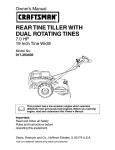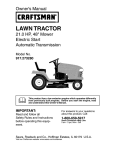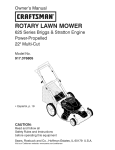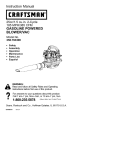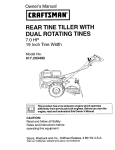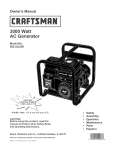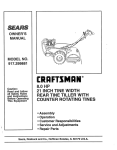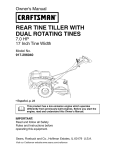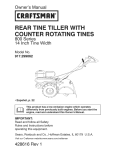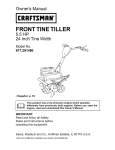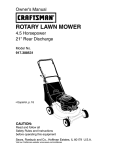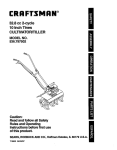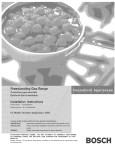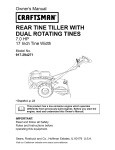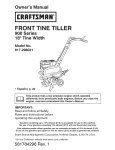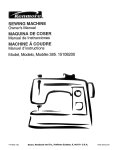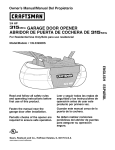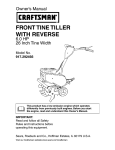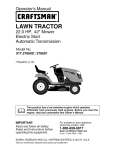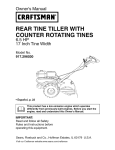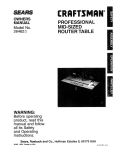Download ICRIIFTSMIIN°I
Transcript
Owner's Manual
ICRIIFTSMIIN°I
REAR TINE TILLER WITH
DUAL ROTATING TINES
7.0 HP
17 Inch Tine Width
Model No.
917.294270
• Espahol, p. 23
This product has a low emission engine which operates
differently from previously built engines. Before you start the
engine, read and understand this Owner's Manual.
IMPORTANT:
Read and follow all Safety
Rules and Instructions before
operating
this equipment.
Sears, Roebuck and Co., Hoffman Estates, IL 60179
Visit our Craftsman
website:www.sears.com/craftsman
U.S.A.
Maintenance .......................................14
Serviceand Adjustments.....................16
Storage................................................
20
Troubleshooting...................................21
IllustratedParts List.............................44
Sears Service........................Back Cover
Warranty................................................
2
SafetyRules..........................................2
ProductSpecifications .........................4
Assembly/Pre-Operation.......................6
Operation...............................................
8
MaintenanceSchedule........................14
LIMITED TWO YEAR WARRANTY ON CRAFTSMAN TILLER
For two (2) years from date of purchase, when this Craftsman Tiller is maintained,
lubricated, and tuned up according to the operating and maintenance instructions in the
owner's manual, Sears will repair free of charge any defect in material or workmanship.
This Warranty does not cover:
• Expendable items which become worn during normal use, such as tines, spark plugs,
air cleaners and belts.
• Repairs necessary because of operator abuse or negligence, including bent crankshafts and the failure to maintain the equipment according to the instructions contained in the owner's manual.
• If this Craftsman Tiller is used for commercial or rental purposes, this Warranty applies
for only thirty (30) days from the date of purchase.
Warranty service is available by returning the craftsman power mower to the nearest
sears service center!department
in the united states. This warranty applies only while
this product is in use in the united states.
This Warranty gives you specific legal rights, and you may also have other rights which
vary from state to state.
SEARS,
ROEBUCK
AND CO., D/817WA,
HOFFMAN
ESTATES,
IL 60179
U.S.A.
IMPORTANT: This cutting machine is capable of amputating hands and feet and throwing objects. Failure to observe the following safety instructions could result in serious
injury or death.
TRAINING
• Disengage all clutches and shift into
neutral before starting the engine (motor).
• Do not operate the equipment without
wearing adequate outer garments. Wear
footwear that will improve footing on
slippery surfaces.
• Handle fuel with care; it is highly flammable.
• Use an approved fuel container.
• Never add fuel to a running engine or
hot engine.
• Fill fuel tank outdoors with extreme care.
Never fill fuel tank indoors.
• Replace gasoline cap securely and
clean up spilled fuel before restarting.
• Read the Owner's Manual carefully. Be
thoroughly familiar with the controls and
the proper use of the equipment. Know
how to stop the unit and disengage the
controls quickly.
• Never allow children to operate the
equipment. Never allow adults to operate the equipment without proper
instruction.
• Keep the area of operation clear of all
persons, particularly small children, and
pets.
PREPARATION
• Thoroughly inspect the area where the
equipment is to be used and remove all
foreign objects.
2
• Use extension cords and receptacles
as specified by the manufacturer for all
units with electric drive motors or electric starting motors.
• Never attempt to make any adjustments
while the engine (motor) is running (except where specifically recommended
by manufacturer).
• Never operate the machine at high
speeds on slippery surfaces. Look behind and use care when backing.
• Never allow bystanders near the unit.
• Use only attachments and accessories
approved by the manufacturer of the
tiller.
• Never operate the tiller without good visibility or light.
• Be careful when tilling in hard ground.
The tines may catch in the ground and
propel the tiller forward. If this occurs,
let go of the handlebars and do not
restrain the machine.
OPERATION
• Do not put hands or feet near or under
rotating parts.
• Exercise extreme caution when operating on or crossing gravel drives, walks,
or roads. Stay alert for hidden hazards
or traffic. Do not carry passengers.
• After striking a foreign object, stop the
engine (motor), remove the wire from
the spark plug, thoroughly inspect the
tiller for any damage, and repair the
damage before restarting and operating
the tiller.
• Exercise caution to avoid slipping or falling.
• If the unit should start to vibrate abnormally, stop the engine (motor) and
check immediately for the cause. Vibration is generally a warning of trouble.
• Stop the engine (motor) when leaving
the operating position.
• Take all possible precautions when leaving the machine unattended. Disengage
the tines, shift into neutral, and stop the
engine.
• Before cleaning, repairing, or inspecting,
shut off the engine and make certain all
moving parts have stopped. Disconnect
the spark plug wire, and keep the wire
away from the plug to prevent accidental
starting. Disconnect the cord on electric
motors.
• Do not run the engine indoors; exhaust
fumes are dangerous.
• Never operate the tiller without proper
guards, plates, or other safety protective
devices in place.
• Keep children and pets away.
• Do not overload the machine capacity
by attempting to till too deep at too fast
a rate.
MAINTENANCE
AND STORAGE
• Keep machine, attachments, and accessories in safe working condition.
• Check shear pins, engine mounting
bolts, and other bolts at frequent intervals for proper tightness to be sure the
equipment is in safe working condition.
• Never store the machine with fuel in the
fuel tank inside a building where ignition
sources are present, such as hot water
and space heaters, clothes dryers, and
the like. Allow the engine to cool before
storing in any enclosure.
• Always refer to the operator's guide
instructions for important details if the
tiller is to be stored for an extended
_period.
Look for this symbol to point out
important safety precautions. It means
CAUTION!!!
BECOME ALERT!!! YOUR
SAFETY IS INVOLVED.
_CAUTION:
Always disconnect spark
plug wire and place wire where it cannot
contact spark plug in order to prevent accidental starting when setting up, transporting, adjusting or making repairs.
_WARNING:
Engine exhaust, some of its
constituents, and certain vehicle components contain or emit chemicals known to
the State of California to cause cancer and
birth defects or other reproductive harm.
3
Gasoline
Capacity:
4 Quarts
Unleaded
Regular
Oil (API-SF-SJ):
(Capacity: 19 oz.)
SAE 30 (Above 40°F)
SAE5w-30/10W-30
(Below 40°F)
In the state of California the above is
required by law (Section 4442 of the
California Public Resources Code). Other
states may have similar laws. Federal
taws apply on federal lands. A spark arrester for the muffler is available through
your nearest Sears service center (See
REPAIR PARTS section of this manual).
Spark
(Gap:
Champion
RC12YC
REPAIR PROTECTION
AGREEMENTS
PRODUCT
SPECIFICATIONS
Plug :
.030")
Congratulations on making a smart purchase. Your new CraftsmanO product is
designed and manufactured for years of
dependable operation. But like all products,
it may require repair from time to time. That's
when having a Repair Protection Agreement
can save you money and aggravation.
Purchase a Repair Protection Agreement
now and protect yourself from unexpected
hassle and expense.
Here's what's included in the Agreement:
• Expert service by our 12,000 profesional repair specialists.
• Unlimited service and no charge for
parts and labor on all covered repairs.
• Product replacement if your covered
product can't be fixed.
• Discount of 10% from regular price of
service and service-related parts not
covered by the agreement; also, 10%
off regular price of preventive maintenance check.
• Fast help by phone - phone support
from a Sears technician on products
requiring in-home repair, plus convenient repair scheduling.
Once you purchase the Agreement, a
simple phone call is all that it takes for you
to schedule service. You can call anytime
day or night, or schedule a service appointment online.
Sears has over 12,000 professional repair
specialists, who have access to over 4.5
million quality parts and accessories.
That's the kind of professionalism you can
count on to help prolong the life of your
new purchase for years to come. Purchase
your Repair Protection Agreement today!
Some limitations
and exclusions apply.
For prices and additional
information
call 1-800-827-6655.
CONGRATULATIONS
on your purchase
of a Sears Tiller. It has been designed,
engineered and manufactured to give you
the best possible dependability and performance.
Should you experience any problems you
cannot easily remedy, please contact a
Sears or other qualified Service Center.
We have competent, welt-trained technicians and the proper tools to service or
repair this unit.
Please read and retain this manual. The
instructions wilt enable you to assemble
and maintain your tiller properly. Always
observe the "SAFETY RULES".
Your new tiller has been assembled at the
factory with exception of those parts left
unassembled for shipping purposes. To
ensure safe and proper operation of your
tiller all parts and hardware you assemble
must be tightened securely. Use the correct tools as necessary to insure proper
tightness.
CUSTOMER
RESPONSIBILITIES
• Read and observe the safety rules.
• Follow a regular schedule in maintaining, caring for and using your tiller.
• Follow the instructions under the "Maintenance" and "Storage" sections of this
_LOwne r's Manual.
WARNING: This unit is equipped with
an internal combustion engine and should
not be used on or near any unimproved
forest-covered, brush-covered or grass
covered land unless the engine's exhaust
system is equipped with a spark arrester
meeting applicable local or state laws (if
any). If a spark arrester is used, it should
be maintained in effective working order
by the operator.
SEARS
INSTALLATION
SERVICE
For Sears professional installation of home
appliances, garage door openers, water
heaters, and other major home items, in
the U.S.A. call 1-800-4-MY-HOME®
4
These accessories were available when the tiller was purchased. They are also available at most Sears Retail outlets and Service Centers. Most Sears Stores can order
repair parts for you when you provide the model number of your tiller.
ENGINE
SPARK
TILLER
PLUG
MUFFLER
AIR FILTER
GAS CAN
ENGINE OIL
STABILIZER
PERFORMANCE
FURROW
OPENER
TILLER MAINTENANCE
BELT
TINES
SHEAR
PIN
HAIRPIN
CLIP
II
CONTENTS
OF HARDWARE
PACK
@
(1) Center Locknut
3/8-16 UNC
(2) Handle Locks
(1) Carriage Bolt
(1) Cable Clip
I
(1) Hairpin Clips
3/8-16 UNC x 1 Gr. 5
(
(
)
)
(1) Pivot Bolt
3/8-16 UNC Grade 5
o
(2) Shear
I
0
13/32 x 1 xll
Ga.
(1) Handle Lock Lever
Pins & Clips
5
Your new tiller has been assembled at the factory with the exception of those parts left
unassembled for shipping purposes. To ensure safe and proper operation of your tiller
all parts and hardware you assemble must be tightened securely. Use the correct tools
as necessary to insure proper tightness.
TOOLS REQUIRED
FOR
ASSEMBLY
A socket wrench set will make assembly
easier. Standard wrench sizes are listed.
(1) Utility knife
(1) Wire cutter
(1) Tire pressure gauge
(1) Screwdriver
(1) Pair of pliers
(1) 9/16" wrench
OPERATOR'S
5. Remove packing material from handle
assembly.
Shift Rod
Handle
Assembly
POSITION
When right or left hand is mentioned in
this manual, it means when you are in the
operating position (standing behind tiller
handles).
INSTALL
1.
FRONT
LEFT
_.
RIGHT
HANDLE
Insert one handle lock (with teeth facing outward) in gearcase notch. (Apply
grease on smooth side of handle lock
to aid in keeping lock in place until
handle assembly
is lowered into position.)
VIEWED FROM R.H. SIDE OFTILLER
Handle Assembly
Gearcase Notch
Handle Lock
OPERATOR'S
POSITION
UNPACKING
2. Grasp handle assembly. Hold in "up"
position. Be sure handle lock remains
in gearcase notch. Slide handle assembly into position.
CARTON
A(_CAUTION: Be careful of exposed staples when handling or disposing of cartoning material.
IMPORTANT: When unpacking and assembling tiller, be careful not to stretch or
kink cables.
1. While holding handle assembly, cut
cable ties securing handle assembly to
top frame. Let handle assembly rest
on tiller.
2. Remove top frame of carton.
3. Slowly ease handle assembly up and
place on top of carton.
4. Cut down right hand front and right
hand rear corners of carton. Lay side
carton wall down.
Assembly
"UP" Position
Tighten handle
lock lever to hold
Loosen Handle
Lock Lever to
Move
6
3.
4.
5.
CONNECT
Rotate handle assembly down. Insert
rear carriage bolt first, with head of
bolt on L.H. side of tiller and loosely assemble Iocknut.
SHIFT
ROD
1.
Insert end of shift rod into hole of shift
lever indicator.
2.
Insert hairpin clip through
rod to secure.
Insert pivot bolt in front part of plate
and tighten.
Cut down left hand rear corner of car-
hole of shift
Shift Lever
Hairpin ._
ton. Lay rear carton walt down, which
wilt remove the protective cardboard
flap from leveling shield.
6. Cut down remaining corners of carton
and lay panels flat.
7. Lower the handle assembly.
Tighten
nut on carriage bolt so handle moves
with some resistance.
This wilt allow
for easier adjustment.
8. Place flat washer on threaded end of
handle lock lever.
Indicator
Shift Rod
9.
Insert handle lock lever through handle
base and gearcase.
Screw in handle
lock lever just enough to hold lever in
place.
10. Insert the smaller silver handle lock
REMOVE TILLER FROM CRATE
1. Adjust handle assemby to lowest
position. Be sure lock lever is tightened
securely.
2. Make sure shift lever indicator is in "N"
(with teeth inward) in the slot of the
handle base (just inside of washer).
11. With handle assembly in lowest position, securely tighten handle lock lever
by rotating clockwise.
Leaving handle
assembly in lowest position will make it
easier to remove tiller from carton.
Flat Washer
Handle Lock
\
3.
4.
Handle Lock
Lever
CHECKTIRE
Rear
HANDLE
HEIGHT
• Handle height may be adjusted to better suit operator. (See "TO ADJUST
HANDLE HEIGHT" in the Service and
Adjustments section of this manual).
Locknut "1
Handle Base
•
CABLE
CLIP
Insert plastic cable clip into hole on the
back of handle column.
Push cables
into clip.
Handle Column
ip
handles
PRESSURE
The tires on your unit were overinflated
at
the factory for shipping purposes.
Correct
and equal tire pressure is important for
best tilling performance.
• Reduce tire pressure to 20 PSI.
Cartridge
Bolt
INSERT
(neutral) position.
Tilt tiller forward by lifting handle. Separate cardboard
cover from leveling
shield.
Rotate tiller handle to the right and pull
tiller out of carton.
14
7
These symbols may appearon yourTiller or in literaturesupplied with the product.
Learn and understandtheir meaning.
KNOW YOUR TILLER
READ THIS OWNER'S
TILLER.
MANUAL
AND
SAFETY
RULES
BEFORE
Compare
the illustrations
with your tiller to familiarize
yourself
various
controls
and adjustments.
Save this manual for future
OPERATING
YOUR
with the location
reference.
of
Throttle Control
Drive Control Bar
Shift Lever Indicator
Drac
Leveling Shield
Recoil
Starter
Handle
Outer Side Shield
MEETS ANSI SAFETY REQUIREMENTS
Our tillers conform to the safety standards
of the American National Standards
Institute.
THROTTLE CONTROL - Used to control
engine speed.
LEVELING SHIELD - Levels tilled soil.
SHIFT LEVER - Used to shift transmission
gears.
SHIFT LEVER INDICATOR - Shows
which gear the transmission is in.
RECOIL STARTER HANDLE - Used to
start the engine.
DRIVE CONTROL BAR - Used to engage
tines.
DEPTH STAKE - Controls depth at which
tiller will dig.
DRAG STAKE - Controls forward speed in
forward rotating tilt position.
OUTER SIDE SHIELD - Adjustable to
protect small plants from being buried.
8
The operation of any tiller can result in foreign objects
which can result in severe eye damage.
Always wear
shields before starting your tiller and while tilling. We
safety glasses or a wide vision safety mask worn over
HOW TO USE YOUR TILLER
HARD
Know how to operate all controls before
adding fuel and oil or attempting to start
engine.
• Briefly engage drive control bar and release or rock tiller forward and backward
until are able to shift gears.
STOPPING
TINES AND DRIVE
DEPTH STAKE
Shallowest Tilling -....._
_" Transport Position
Deepest Tilling -Depth Stake
Drive Control Bar
Shift Lever
Position-_.
DRAG STAKE
The drag stake should be raised when
tilling the counter rotating (_) tilt position.
The drag stake should be lowered when
tilling in the forward rotating (_) till position.
Drive Control Bar
"DISENGAGED"
Position
Throttle Control
TINE OPERATION
DRIVE
GEARS
The depth stake can be raised or lowered
to allow you more versatile tilling and cultivating, or to more easily transport your
tiller.
1. Release drive control bar to stop movement.
2. Move shift lever to "N" (neutral) position.
ENGINE
• Move throttle control to "STOP" position.
If equipped with stop switch, move
switch to "STOP" position.
NOTE: Never use choke to stop engine.
"ENGAGED"
TO SHIFT
thrown into the eyes,
safety glasses or eye
recommend
standard
spectacles.
- WITH WHEEL
Lowered
• Always release drive control bar before
moving shift lever into another position.
• Tine movement is achieved by moving
shift lever to either the counter rotating
(_) till position or the forward rotating
(_) tilt position and engaging drive control bar.
FORWARD - WHEELS ONLY/TINES
STOPPED
• Release drive control bar and move shift
lever indicator to "F" (forward) position.
Engage drive control bar and tiller will
move forward.
REVERSE - WHEELS ONLY/TINES
STOPPED
1. DO NOT STAND DIRECTLY BEHIND
TILLER.
2. Release the drive control bar.
3. Move throttle control to "SLOW" position.
4. Move shift lever indicator to "R" (reverse) position.
5. Hold drive control bar against the
handle to start tiller movement.
(Forward Rotating till)
Raised
(Counter rotating tilt)
TILLING
NOTE: Use the counter rotating tine drive
when tilling hard or rockey soil, virgin
ground or sod.
1. Release depth stake and drag stake
pins. Pull the depth stake up for
increased tilling depth. Raise the drag
stake. Place proper pin in hole of depth
stake or drag stake to lock in position.
2. Place shift lever indicator in counter
rotating (_) tilt position.
3. Hold the drive control bar against the
handle to start tilling movement. Tines
and wheels will both turn.
9
4. Movethrottle controlto "FAST"position
for deep tilling.
IMPORTANT:Alwaysreleasedrive control
bar beforemoving shift leverinto another
position.
IMPORTANT: Always lower the drag
stake when using the forward rotating tine
drive.
OUTER
\ Depth or Drag
The back edges of the outer side shields
are slotted so that the shields can be
raised for deep tilling and lowered for
shallow tilling to protect small plants from
being buried.
1. Loosen nut "A" in slot and nut "B".
2. Move shield to desired position (both
sides).
3. Retighten nuts.
/_Stake Pin
TO TRANSPORT
"Locked" Position
\
_'Released"
Nut
\
_,/
"B"
Nut"A" \_,_,,¢'_-'J
Outer Side
Shield
SIDE SHIELDS
_CAUTION:
Before lifting or transporting,
allow tiller engine and muffler to cool. Disconnect spark plug wire. Drain gasoline
from fuel tank.
AROUND THE YARD
Position
1. Release the depth stake pin. Move
the depth stake down to the top hole
for transporting the tiller. Place depth
stake pin in hole of depth stake to lock
in position. This prevents tines from
scuffing the ground.
2. Place shift lever indicator in "F" (forward) position for transporting.
3. Hold the drive control bar against the
handle to start tiller movement. Tines
will not turn.
4. Move throttle control to desired speed.
AROUND TOWN
1. Disconnect spark plug wire.
2. Drain fuel tank.
3. Transport in upright position to prevent
oil leakage.
TURNING
1. Release the drive control bar.
2. Move throttle control to "SLOW" position.
3. Place shift lever indicator in "F" (forward) position. Tines wilt not turn.
4. Lift handle to raise tines out of ground.
5. Swing the handle in the opposite
direction you wish to turn, being careful
to keep feet and legs away from tines.
6. When you have completed your turnaround, release the drive control bar
and lower handle. Place shift lever in
(till) position and move throttle control
to desired speed. To begin tilling, hold
drive control bar against the handle.
CULTIVATING
BEFORE
NOTE: Use the forward rotating tine drive
when cultivating, tilling soft ground or tilling pre-titted soil.
1. Release the depth and drag stake pins.
Lower drag stake. Pull the depth stake
up for increased tilling depth. Place
proper pin in hole of depth stake or
drag stake to lock in position.
2. Place shift lever indicator in forward to
rotating (_) tilt position.
3. Hold the drive control bar against the
handle to start tilling movement. Tines
and wheels will both turn.
4. Move throttle control "FAST" position
for deep tilling. To cultivate, throttle
control can be set at any desired
speed, depending on how fast or stow
you wish to cultivate.
STARTING
ENGINE
IMPORTANT: Be very careful not to allow
dirt to enter the engine when checking or
adding oil or fuel. Use clean oil and fuel
and store in approved, clean, covered
containers, use clean fill funnels.
CHECK ENGINE OIL LEVEL
The engine in your unit has been shipped,
from the factory, already filled with SAE 30
summer weight oil.
1. With engine level, clean area around
oil filler plug and remove plug.
2. Engine oil should be to point of overlowing when engine is level.
• For approximate capacity see "PRODUCT SPECIFICATIONS" on page 4
of this manual. All oil must meet A.RI.
Service Classification SF-SJ.
3. Reinstall engine oil cap and tighten
10
TO START
• For cold weather operation you should
change oil for easier starting (See oil
viscosity chart in the Maintenance section of this manual).
• To change engine oil, see the Maintenance section in this manual.
ENGINE
_CAUTION:
Keep tine control in "OFF"
position when starting engine.
When starting engine for the first time or if
engine has run out of fuel, it will take extra
pulls of the recoil starter to move fuel from
the tank to the engine.
1. Make sure spark plug wire is properly
connected.
2. Move shift lever indicator to "N" (neutral) position.
3. Place throttle control in "FAST" position.
4. Turn fuel shut-off valve 1/4 turn to open
position.
5. Push stop switch to "ON" position.
6. Move choke control to "CHOKE" position.
7. Grasp recoil starter handle with one
hand and grasp tiller handle with other
hand. Pull rope out slowly until engine
reaches start of compression cycle
(rope wilt pull slightly harder at this
point).
8. Pull recoil starter handle quickly. Do
not let starter handle snap back
against starter.
NOTE: If engine fires but does not start,
move choke control to half choke position. Pull recoil starter handle until engine
starts.
9. When engine starts, slowly move
choke control to "RUN" position as
engine warms up.
NOTE: A warm engine requires tess
choking to start.
10. Move throttle control to desired running
position.
11 .Allow engine to warm up for a few
minutes before engaging tines.
NOTE: If at a high altitude (3000 feet) or
in cold temperatures (below 32°F), the
carburetor fuel mixture may need to be
adjusted for best engine performance.
See "TO ADJUST CARBURETOR" in the
Service and Adjustments section of this
manual.
NOTE: If engine does not start, see troubleshooting points.
Oil
ADD GASOLINE
• Fill fuel tank to bottom of filler neck. Do
not overfill. Use fresh, clean, regular
unleaded gasoline with a minimum of
87 octane. (Use of leaded gasoline will
increase carbon and lead oxide deposits and reduce valve life). Do not mix oil
with gasoline. Purchase fuel in quantities that can be used within 30 days to
assure fuel freshness.
_CAUTION:
Fill to within 1/2 inch of top
of fuel tank to prevent spills and to allow
for fuel expansion. If gasoline is accidentally spilled, move machine away from
area of spill. Avoid creating any source of
ignition until gasoline vapors have disappeared.
Wipe off any spilled oil or fuel. Do not
store, spill or use gasoline near an open
flame.
IMPORTANT: When operating in temperatures below32°F(0°C), use fresh, clean
winter grade gasoline to help insure good
cold weather starting.
CAUTION: Alcohol blended fuels (called
gasohol or using ethanol or methanol) can
attract moisture which leads to separation and formation of acids during storage.
Acidic gas can damage the fuel system
of an engine while in storage. To avoid
engine problems, the fuel system should
be emptied before storage of 30 days
or longer. Drain the gas tank, start the
engine and let it run until the fuel lines
and carburetor are empty. Use fresh fuel
next season. See Storage Instructions for
additional information. Never use engine
or carburetor cleaner products in the fuel
tank or permanent damage may occur.
Fuel shut-off
Choke controls
,i
Rewind start_
11
i
TILLING
HINTS
CULTIVATING
_CAUTION:
Until you are accustomed
to handling your tiller, start actual field
use with throttle in slow position (mid-way
between "FAST" and "IDLE").
• Tilling is digging into, turning over, and
breaking up packed soil before planting. Loose, unpacked soil helps root
growth. Best tilling depth is 4" to 6". A
tiller will also clear the soil of unwanted
vegetation. The decomposition of this
vegetable matter enriches the soil.
Depending on the climate (rainfall and
wind), it may be advisable to till the soil
at the end of the growing season to
further condition the soil.
• Soil conditions are important for proper
tilling. Tines wilt not readily penetrate
dry, hard soil which may contribute to
excessive bounce and difficult handling
of your tiller. Hard soil should be moistened before tilling; however, extremely
wet soil will "ball-up" or clump during tilling. Wait until the soil is less wet in order
to achieve the best results. When tilling
in the fall, remove vines and long grass
to prevent them from wrapping around
the tine shaft and slowing your tilling
operation.
• You wilt find tilling much easier if you
leave a row untilled between passes.
Then go back between tilled rows.There
are two reasons for doing this. First,
wide turns are much easier to negotiate than about-faces. Second, the tiller
won't be pulling itself, and you, toward
the row next to it.
• Do not lean on handle. This takes
weight off the wheels and reduces
traction. To get through a really tough
section of sod or hard ground, apply
upward pressure on handle or lower the
depth stake.
Cultivating is destroying the weeds between rows to prevent them from robbing
nourishment and moisture from the plants.
At the same time, breaking up the upper
layer of soil crust will help retain moisture
in the soil. Best digging depth is 1" to 3"
(2.5-7.5 cm). Lower the outer side shields
to protect small plants from being buried.
• Cultivate up and down the rows at a
speed which will allow tines to uproot
weeds and leave the ground in rough
condition, promoting no further growth
of weeds and grass.
• Do not lean on handle, this takes weight
off the wheels, reduces traction, and
may cause the tiller to skip over the
ground.
• Always lower the drag stake when
using the forward rotating tine drive.
TINE SHEAR
PINS
The tine assemblies on your tiller are
secured to the tine shaft with shear pins
(See "TINE REPLACEMENT" in the
Service and Adjustments section of this
manual).
If the tiller is unusually overloaded or
jammed, the shear pins are designed to
break before internal damage occurs to
the transmission.
• If shear pin(s) break, replace only with
those shown in the Repair Parts section
of this manual.
12
ADJUST WHEELS FOR
CULTIVATING
OUTER VIEW OF TIRE
_
1. Place blocks under right hand side of
tiller and remove hairpin clip and clevis
pin from right hand wheel.
2. Move wheel outward approximately 1
inch until hole in inner wheel hub lines
up with inner hole in axle.
3. Replace clevis pin and hairpin clip on
inside of wheel and remove blocks.
4. Repeat preceding steps on left hand
side.
NOTE: In extremely rough conditions and
while cultivating, the wheels should be
moved outward on the axle for increased
levis
Pin
in Cltip
INNER VIEW OF TIRE
stability.
Clevis
Pin
Hairpin
13
MAINTENANCE
SCHEDULE
_
FILL IN DATES
AS YOU COMPLETE
REGULAR SERVICE
Check
Engine
Change
/_/_,_/_._/_._/
Oil Level
Engine
I1_
S E RVtCE
DATES
I_
Oil
I_,_.
Oil Pivot Points
Inspect
Spark Arrester
Inspect
Air Screen
Clean or Replace
Clean Engine
Replace
/ Muffler
Air Cleaner
Cylinder
Cartridge
Fins
Spark Plug
RH Gear Case Grease
Fi_ing (loz,)
1 - Change more often when operating under a heavy loador in high
2 - Service more often when operating in dirty or dusty conditions.
GENERAL
ambient
RECOMMENDATIONS
LUBRICATION
The warranty on this tiller does not cover
items that have been subjected to operator abuse or negligence. To receive full
value from the warranty, the operator must
maintain tiller as instructed in this manual.
Some adjustments will need to be made
periodically to properly maintain your tiller.
At least once a season, check to see if
you should make any of the adjustments
described in the Service and Adjustments
section of this manual.
• Once a year you should replace the
spark plug, clean or replace air filter,
and check tines and belts for wear. A
new spark plug and clean air filter assure proper air-fuel mixture and help
your engine run better and last longer.
BEFORE
temperatures.
EACH
CHART
@Throttle Control
@Engil
®RH Gear Case
Grease Fitting
Pin
Shield
Hinges
Otdler
Bracket
@Wheel Hub
@ SAE 30 OR 10W-30 Motor Oil
@ Referto Maintenance "ENGINE"section
® EP #1 Grease
USE
1. Check engine oil level.
2. Check tine operation.
3. Check for loose fasteners.
LUBRICATION
Keep unit well lubricated (See "LUBRICATION CHART").
14
5.
_CAUTION:
Disconnect spark plug
wire before performing any maintenance
(except carburetor adjustment) to prevent
accidental starting of engine.
Prevent fires! Keep the engine free of
grass, leaves, spilled oil, or fuel. Remove
fuel from tank before tipping unit for maintenance. Clean muffler area of all grass,
dirt, and debris.
Do not touch hot muffler or cylinder fins as
contact may cause burns.
Refill engine with oil. See "CHECK
ENGINE OIL LEVEE' in the Operation
section of this manual.
Oil drain
Plu4
ENGINE
Oil Fill Plug
LUBRICATION
Use only high quality detergent oil rated
with API service classification SF-SJ. Select the oil's SAE viscosity grade according to your expected temperature.
SAE VtSCOS{TY
AIR FILTER
Your engine wilt not run properly using a
dirty air filter. Clean the foam pre-cleaner
after every 50 hours of operation or every
season. Service paper cartridge every
100 hours of operation or every season,
whichever occurs first.
Service air cleaner more often under dusty
conditions.
1. Remove knob and cover. Lift air
cleaner assembly off stud.
TO SERVICE PRE-CLEANER
GRADES
F
TEMPERATURE
RANGE ANTICIPA FED BEFORE NEXT OiL CHANGE
ol vi_
dar_S
e(drO
NOTE: Although multi-viscosity oils
(5W-30, 10W-30, etc.) improve starting
in cold weather, these multi-viscosity oils
will result in increased oil consumption
when used above 40°F (4°C). Check your
engine oil level more frequently to avoid
possible engine damage from running tow
on oil.
Change the oil after every 50 hours of
operation or at least once a year if the tiller
is not used for 50 hours in one year.
Check the crankcase oil level before
starting the engine and after each five (5)
hours of continuous use. Add SAE 30 motor oil or equivalent. Tighten oil filler plug
securely each time you check the oil level.
TO CHANGE
ENGINE
2. Remove foam pre-cleaner from air
filter.
3. Wash it in liquid detergent and water.
4. Squeeze it dry in a clean cloth.
NOTE: If very dirty or damaged, replace
pre-cleaner.
5. Reinstall pre-cteaner onto air filter.
6. Reinstall cover and secure with knob.
TO SERVICE
CARTRIDGE
1. Carefully remove cartridge to prevent
debris from entering carburetor. Clean
base carefully to prevent debris from
entering carburetor.
2. Remove foam pre-cleaner from air
filter.
3. Clean cartridge by tapping gently on
flat surface. If very dirty or damaged,
replace cartridge.
4. Reinstall pre-cteaner onto air filter.
5. Reinstall cover and secure with knob.
IMPORTANT: Petroleum solvents, such
as kerosene, are not to be used to clean
the cartridge. They may cause deterioration of the cartridge. Do not oil cartridge.
Do not use pressurized air to clean or dry
cartridge.
OIL
Determine temperature
range expected
before oil change.
All oil must meet API
service classification
SF-SJ.
• Be sure tiller is on level surface.
• Oil will drain more freely when warm.
• Use a funnel to prevent oil spill on tiller,
and catch oil in a suitable container.
1. Remove drain plug.
For easier removal of plug use 7/16- 12
Pt. socket with extension.
2. Tip tiller forward to drain oil.
3. After oil has drained completely,
replace oil drain plug and tighten securely.
4. Remove oil filler plug. Be careful not to
allow dirt to enter the engine.
15
MUFFLER
__Cover
Prlciilrn_
Knob
Do not operate tiller without muffler. Do
not tamper with exhaust system. Damaged mufflers or spark arresters could
create a fire hazard. Inspect periodically
and replace if necessary. If your engine is
equipped with a spark arrester screen assembly, remove every 50 hours for cleaning and inspection. Replace if damaged.
SPARK PLUG
Cartndge
sto0-{
Base
Replace spark plugs at the beginning of
each tilling season or after every 50 hours
of use, whichever comes first. Spark plug
type and gap setting is shown in "PRODUCT SPECIFICATIONS" on page 4 of this
manual.
TRANSMISSION
Once a season, lubricate the right hand
gear case grease fitting with 1 oz. of EP
#1 grease.
_
COOLING SYSTEM
Your engine is air cooled. For proper engine performance and long life keep your
engine clean.
• Clean air screen frequently using a stiffbristled brush.
• Keep cylinder fins, levers, and linkage
free of dirt and chaff.
CLEANING
Do not clean your tiller when the engine
and transmission are hot. We do not recommend using pressurized water (garden
hose, etc.) to clean your unit unless the
gasket area around the transmission and
the engine muffler, air filter and carburetor
are covered to keep water out. Water in
engine will shorten the useful life of your
tiller.
• Clean engine, wheels, finish, etc. of all
foreign matter.
• Keep finished surfaces and wheels free
of all gasoline, oil, etc.
• Protect painted surfaces with automotive type wax.
•Blower
Housing
Air Screen
Muffler
_CAUTION:
Disconnect spark plug wire
from spark plug and place wire where it
cannot come into contact with plug.
-Handle (High) Position
TILLER
Handle Lock Lever
TO ADJUST HANDLE HEIGHT
Select handle height best suited for your
tilling conditions. Handle height will be
different when tiller digs into soil.
1. First loosen handle lock lever.
2. Handle can be positioned at different
settings between "HIGH" and "LOW"
positions.
3. Retighten handle lock lever securely
after adjusting.
Handle (Low)
Position
16
TIRE CARE
Guard
. Hex
Nut and
Washer
(Located
Behind
At_CAUTION: When mounting tires, unless
beads are seated, overinflation can cause
an explosion.
• Maintain 20 pounds of tire pressure. If
tire pressures are not equal, tiller will
pull to one side.
• Keep tires free of gasoline or oil which
can damage rubber.
TO REMOVE WHEEL
1. Place blocks under transmission to
keep tiller from tipping.
2. Remove hairpin clip and clevis pin from
wheel.
3. Remove wheel and tire.
4. Repair tire and reassemble.
Screws
Hairpin Clip and Clevis Pin
TO REPLACE
GROUND
DRIVE
BELT
1. Remove belt guard as described
REMOVE
BELT GUARD".
2.
3.
Pin
4.
5.
6.
in "TO
Remove old belt by slipping off engine
pulley first then remove from transmission pulley.
Place new belt in groove of transmission pulley and into engine pulley.
BELT MUST BE IN GROOVE ON TOP
OF IDLER PULLEY.
NOTE POSITION
OF BELT TO GUIDES.
Check belt adjustment
as described
below.
Replace belt guard.
Reposition
wheel and replace
pin and hairpin clip.
clevis
GROUND DRIVE BELT ADJUSTMENT
tire:
For proper belt tension, the extension
spring should have about 5/8 inch stretch
when drive control bar is in "ENGAGED"
position. This tension can be attained as
follows:
1. Loosen cable clip screw securing the
drive control cable.
2. Slide cable forward for less tension and
rearward for more tension until about
5/8 inch stretch is obtained while the
drive control bar is engaged.
3. Tighten cable clip screw securely.
Hairpin Clip
TO REMOVE BELT GUARD
NOTE: For ease of removal, remove hairpin clip and clevis pin from left wheel. Pull
wheel out from tiller about 1 inch.
1. Remove two (2) screws from side of
belt guard.
2. Remove hex nut and washer from
bottom of belt guard (located behind
wheel).
3. Pull belt guard out and away from unit.
4. Replace belt guard by reversing above
procedure.
Clip Screw
Engine Pulley,
Cable
More Tension
Idler Pulley
Extension Sprinc
Transmission
Pulley
17
TINE
REPLACEMENT
° To maintain
mance
_CAUTION:
Tines are sharp. Wear
gloves or other protection when handling
tines.
A badly worn tine causes your tiller to
work harder and dig more shallow. Most
important, worn tines cannot chop and
shred organic matter as effectively nor
bury it as deeply as good tines. A tine this
worn needs to be replaced.
New Tine
\
\\
tilling perforthe tines should
be checked for sharpness,
wear, and
bending, particularly
the tines which
are next to the transmission.
If the gap
between the tines exceeds 3-1/2 inches
they should be replaced or straightened
as necessary.
• For tines that are slightly worn, the
bolted tine and hub assemblies
can be
switched between sides to continue
Worn Tine
\
the superb
of this machine
tilling in the same tilling mode if tilling
in a different mode is desired then the
bolted tine and hub assemblies
should
be switched back to their original side
so that the tine edge with the least wear
will be used.
\
i
_-
Sharp
Edges
Sharp
18
Hairpin Clip
3-1/2" MAX
Sharp
iges
ENGINE
TO ADJUST CARBURETOR
Maintenance, repair, or replacement of
the emission control devices and systems,
which are being done at the customers expense, may be performed by any non-road
engine repair establishment or individual.
Warranty repairs must be performed by an
authorized engine manufacturer's service
outlet.
TO ADJUST THROTTLE CONTROL
CABLE
1. The throttle control has been preset at
the factory and adjustment should not
be necessary. If adjustment is necessary, proceed as follows:
2. With engine not running, move remote
throttle control lever to "FAST" position.
3. If throttle lever on engine touches high
speed stop, no further adjustment is
necessary. If throttle lever does not
touch high speed stop, continue with
adjustment procedure.
4. Loosen cable clamp screw.
5. Move throttle lever up until it touches
high speed stop, and hold in this position.
6. Tighten cable clamp screw securely.
The carburetor has been preset at the
factory and adjustment should not be
necessary. However, engine performance
can be affected by differences in fuel, temperature, altitude or toad. If the carburetor
does need adjustment, contact your nearest authorized service center!department
IMPORTANT: Never tamper with the
engine governor, which is factory set
for proper engine speed. Overspeeding
the engine above the factory high speed
setting can be dangerous. If you think
the engine-governed high speed needs
adjusting, contact your nearest sears or
other qualified service center which has
the proper equipment and experience to
make any necessary adjustments.
Clamp Screw
Casing
and Wire _
'_
X X
ermine art 78
1
_
Governor Control Lever
19
Immediately prepare your tiller for storage
at the end of the season or if the unit wilt
not be used for 30 days or more.
Al_Warning: Never store the tiller with gasoline in the tank inside a building where
fumes may reach an open flame or spark.
Allow the engine to coot before storing in
any enclosure.
NOTE: Fuel stabilizer is an acceptable
alternative in minimizing the formation of
fuel gum deposits during storage. Add
stabilizer to gasoline in fuel tank or storage container. Always follow the mix ratio
found on stabilizer container. Run engine
at least 10 minutes after adding stabilizer
to allow the stabilizer to reach the carburetor. Do not empty the gas tank and
carburetor if using fuel stabilizer.
ENGINE OIL
Drain oil (with engine warm) and replace
with clean oil. (See "ENGINE" in the Maintenance section of this manual).
CYLINDER
TILLER
1. Clean entire tiller (See "CLEANING" in
the Maintenance section of this manual).
2. Inspect and replace belts, if necessary
(See belt replacement instructions in
the Service and Adjustments section of
this manual).
3. Lubricate as shown in the Maintenance
section of this manual.
4. Be sure that all nuts, bolts and screws
are securely fastened. Inspect moving
parts for damage, breakage and wear.
Replace if necessary.
5. Touch up all rusted or chipped paint
surfaces; sand lightly before painting.
1. Remove spark plug.
2. Pour I ounce (29 ml) of oil through
spark plug hole into cylinder.
3. Pull starter handle slowly several times
to distribute oil.
4. Replace with new spark plug.
OTHER
• Do not store gasoline from one season
to another.
• Replace your gasoline can if your can
starts to rust. Rust and/or dirt in your
gasoline will cause problems.
• If possible, store your unit indoors and
cover it to give protection from dust and
dirt.
• Cover your unit with a suitable protective
cover that does not retain moisture. Do
not use plastic. Plastic cannot breathe
which allows condensation to form and
wilt cause your unit to rust.
IMPORTANT: Never cover tiller while engine and exhaust areas are still warm.
ENGINE
FUEL SYSTEM
IMPORTANT: It is important to prevent
gum deposits from forming in essential
fuel system parts such as the carburetor,
fuel filter, fuel hose, or tank during storage.
Also, alcohol blended fuels (called gasohol
or using ethanol or methanol) can attract
moisture which leads to separation and
formation of acids during storage. Acidic
gas can damage the fuel system of an
engine while in storage.
• Empty the fuel tank by starting the engine and letting it run until the fuel lines
and carburetor are empty.
• Never use engine or carburetor cleaner
products in the fuel tank or permanent
damage may occur.
• Use fresh fuel next season.
20
TROUBLESHOOTING
CHART:
See appropriate section in manual unless directed to Sears service center
PROBLEM
Will not start
CAUSE
CORRECTION
1. Out of fuel.
2. Engine not"CHOKED"
properly.
3. Engine flooded.
4. Dirty air cleaner.
5. Water in fuel.
6. Clogged fuet tank.
7. Loose spark plug wire.
8. Bad spark plug or
improper gap.
9. Carburetor out of adjustment.
Hard to start
Loss of power
1. Throttle control not set
properly.
2. Dirty air cleaner.
1. Fill fuel tank.
2. See "TO START ENGINE" in
the Operation section.
3. Wait several minutes before
attempting to start.
4. Clean or replace air cleaner
cartridge.
5. Empty fuet tank and carburetor, and refill tank with fresh
gasoline.
6. Remove fuel tank and clean.
7. Make sure spark plug wire is
seat ed properly on plug.
8. Replace spark plug or adjust
gap.
9. Make necessary adjust
ments.
1.
2.
Place throttle
control
in
"FAST" position.
Clean or replace air cleaner
cartridge.
Replace spark plug or adjust
gap.
Empty fuet tank and refill with
fresh gasoline.
Make sure spark plug wire is
seated properly on plug.
Make necessary
adjust
ments.
3. Bad spark plug or
improper gap.
4. Stale or dirty fuel.
3.
5. Loose spark plug wire.
5.
6. Carburetor out of
adjustment.
6.
1. Engine is overloaded.
1. Set depth stake for shallower
tilling.
2. Clean or replace air cleaner
cartridge.
3. Check oil level/change
oil.
4. Clean and regap or change
spark plug.
5. Empty and clean fuet tank
and refill, and clean carburetor.
6. Empty fuet tank and refill with
fresh gasoline.
7. Empty fuet tank and carburetor, and refill tank with fresh
gasoline.
8. Remove fuel tank and clean.
4.
2. Dirty air cleaner.
3. Low oil level/dirty oil.
4. Faulty spark plug.
5. Oil in fuel.
6. Stale or dirty fuel.
7. Water in fuel.
8.
9.
Clogged fuet tank.
Spark plug wire loose.
10. Dirty engine air screen.
11. Dirty/clogged muffler.
12. Carburetor out of
adjustment.
13. Poor compression.
9.
Connect and tighten spark
ptug wire.
10.Ctean engine air screen.
11. Clean/replace
muffler.
12. Make necessary
adjust
ments.
13.Contact
a Sears or other
qualified
21
service
center.
TROUBLESHOOTING
CHART:
See appropriate section in manual unless directed to Sears service center
PROBLEM
Engine
overheats
CAUSE
CORRECTION
1. Low oil level/dirty oil.
2. Dirty engine air screen.
3. Dirty engine.
4. Partially plugged muffler.
5. Improper carburetor
adjustment.
Excessive
bounce/difficult
handling
1. Ground too dry and hard.
2. Depth stake
incorrectly adjusted.
Soil balls up or
clumps
Engine runs but
tiller won't
move
Engine runs but
labors when
tilling
Tines skip over
ground
1. Ground
.
is not
1. Engage tine control.
engaged.
2. V-belt not correctly
adjusted.
3. V-belt is off pulley(s).
1. Tilling too deep.
2. Throttle control not
properlyadjusted.
3. Carburetor out of adjustment.
1. Drag Stake not lowered
in forward rotating till
mode.
2. Improper tilling mode.
Hard to shift into
gear
1. Gears not timed.
Tillershuts off
when drive
controlbar
engaged
1. Shift lever set in between
2.
1. Moisten ground or wait for
more favorable soil conditions.
2. Adjust depth stake.
1. Wait for more favorable soil
conditions.
too wet.
Tine control
1. Check oil level/change oil.
2. Clean engine air screen.
3. Clean cylinder fins, airscreen, muffler area.
4. Remove and clean muffler.
5. Adjust carburetor to richer
position.
2. Inspect/adjust
3. Inspect V-belt.
1. Set depth stake for shallower
tilling.
2. Check throttle control setting.
3. Make necessary adjust
merits.
1. Lower Drag Stake
.
.
counter rotating till
position and forward
rotating tilt position.
Tines jammed
22
V-belt.
Forward rotating tine drive
should only be used for soft
ground or for soil that has
already been tilled.
Briefly engage drive control
bar and release or rock tiller
forward and backward until
are able to shift gears.
1. Shift to either counter rotating
till position or forward rotating
till position.
2.
Clear tines.
Garantia .......................................................
Regtas de Seguridad ...................................
Especificaciones det producto .....................
Montaje/Pre-Operaci6n
...............................
Operaci6n ....................................................
Programa de Mantenimiento .......................
23
23
25
27
29
35
Mantenimiento .............................................
35
Servicio y Ajustes .......................................
37
Almacenamiento ..........................................
41
Identificaci6n de Problemas ........................ 42
Vea et Manual tngles ............ Ingl6s del DueSo
A_
GARANTIA LIMtTADA DE DOS At_IOS PARA LA CULTIVADORA CRAFTSMAN
Por dos (2) a5os, a partir de la fecha de compra, cuando esta Cuttivadora Craftsman se mantenga,
lubrique y afine segQn tas instrucciones para ta operaci6n y el mantenimiento en et manual del
dueSo, Sears repararfi, gratis, todo defecto en el material y la mano de obra.
Esta Garantia no cubre:
• Articulos que se desgastan durante el use normal tales como los brazos, las bujias, los fittros de
aire y las correas.
• Reparaciones necesarias debido al abuso o a la negligencia del operador, incluyendose a los
cigLieSales dobtados y a ta falta de mantenimiento del equipo segQn las instrucciones que se
inctuyen en el manual del dueSo.
• Si la Cultivadora Craftsman se usa para fines de arriendo, esta garantia se aplica solamente por
treinta (30) treintadias a partir de la fecha de compra.
El Servicio de Garantia esta disponible at devolver la cultivadora Craftsman al centroidepartamento
de servicio Sears mas cercano en los estados unidos.
Esta Garantia se aplica sotamente mientras et producto este en uso en los estados unidos. Esta
Garantia le otorga derechos legales especfficos, y puede que tambi_n tenga otros derechos que
varian de estado a estado.
SEARS, ROEBUCK AND CO., Di817WA, HOFFMAN ESTATES, tL 60179 U.S.A.
IMPORTANTE: Esta Maquina cortadora es capaz de amputar las manosy los pies y de lanzar
objetos, si no se observan las instrucciones de seguridad siguientes se pueden producir lesiones
graves o la muerte.
• Nunca ai_ada combustible a un motor en
funcionamiento o caliente.
• Llene el estanque de combustible afuera con
mucho cuidado. Nunca Itene el estanque de
combustible en un recinto cerrado.
• Vuelva a cotocar la tapa det dep6sito de gasolina en forma segura y limpie et combustible
derramado antes de votver a arrancar.
• Use cordones de extensi6n y receptacutos,
seg6n las especificaciones del fabricante,
para todas las unidades con motores de impulsi6n o con motores de arranque el_ctrico.
• Nunca trate de hacer ningQn ajuste mientras
que et motor est_ funcionando (excepto en
los cases especfficamente recomendados
per el fabricante).
OPERACI(_N
• No ponga ni las manos ni los pies cerca o
debajo de tas piezas rotatorias.
• Tenga mucho cuidado cuando opere o cruce
entradas para autom6viles de ripio, senderos
o caminos. Est_ alerta en Io que se refiere a
los peligros escondidos o al trafico. No lleve
pasajeros.
ENTRENAMIENTO
• Lea el Manual del Due_o cuidadosamente.
Famitiarfcese completamente con los
controtes y con et uso adecuado det equipo.
Sepa c6mo parar la unidad y desenganchar
ios controles rapidamente.
• Nunca permita que los nii_os operen el equipo. Nunca permita que los aduttos operen el
equipo sin los conocimientos adecuados.
• Mantenga el Area de operaci6n despejada de
personas, especialmente niSos pequeSos y
animales dom_sticos.
PREPARACI(_N
• tnspeccione cuidadosamente et Area en
donde se va usar el equipo y remueva los
objetos extrai_os.
• Desenganche todos los embragues y cambie
a neutro antes de hacer arrancar el motor.
• No opere el equipo sin usar ropa exterior
adecuada. Use zapatos que mejoren et equiIibrio en superficies resbalosas.
• Maneje et combustible con cuidado pues es
muy inflamabte.
• Use un envase de combustible aprobado.
23
MANTENIMIENTO
Y ALMACENAMIENTO
• Mantenga los accesorios y aditamentos de
la maquina en buenas condiciones para el
funcionamiento.
• Revise las clavijas de seguro, los pernos
de montaje del motor y otros pernos, a
intervatos frecuentes, para verificar si estan
apretados en forma segura y asegurarse que
el equipo est_ en buenas condiciones de
funcionamiento.
• Nunca guarde la maquina con combustible
en et estanque de combustible dentro de un
edificio en donde hay fuentes de ignici6n
presentes, tales como catentadores de agua
o det ambiente, secadoras de ropa u otros
artefactos parecidos. Permita que se enfrie
et motor antes de guardado en algQn lugar
cerrado.
• Siempre refi_rase alas instrucciones en la
gu[a del operador para ver los detatles de importancia si la cultivadora va a ser guardada
por un periodo de tiempo largo.
Al_,Busque este s[mbolo que seSala las precauclones de seguridad de importancia. Quiere
decir- iiiATENCION!!! iiiESTE ALERTO!!! SU
SEGURtDAD ESTA COMPROMETtDA.
Ai_PRECAUCION: Siempre desconecte el
alambre de la buj/a y p6ngalo donde no pueda
entrar en contacto con la buj/a, para evitar el
arranque por accidente, durante la preparaci6n,
el transporte, el ajuste o cuando se hacen
reparaciones.
_IADVERTENCIA:
El tubo de escape del
motor, algunos de sus constituyentes y atgunos
componentes del vehiculo contienen o desprenden productos quimicos conocidos en el Estado
de California como causa de cancer y defectos
al nacimiento u otros daSos reprocluctivos.
• Despues de pegarle a un objeto extra5o,
pare et motor, remueva et atambre de la
bujia, inspeccione la cuttivadora cuidadosamente, para verificar si hay dai_os, y repare
el daSo antes de voIver a arrancar y operar ta
cultivadora.
• Tenga cuidado para evitar resbalarse o
caerse.
• Si la unidad empieza a vibrar anormalmente,
pare et motor y revisela inmediatamente para
verificar ta causa. La vibraci6n normalmente
es un aviso de problemas.
• Pare el motor cuando abandone la posici6n
de operaci6n.
• Tome todas las precauciones posibles cuando deje la maquina desatendida. Desenganche los brazos, cambie a neutro y pare el
motor.
• Antes de limpiar, reparar e inspeccionar,
apague el motor y asegQrese que todas
Ias partes en movimiento se hart detenido.
Desconecte el atambre de la bujfa, y mant_ngalo alejado de esta para evitar el arranque
por accidente. Desconecte el cord6n en los
motores electricos.
• No haga funcionar el motor en recintos cerrados; los gases de escape son peligrosos.
• Nunca opere la cultivadora sin las protecclones, y las planchas adecuadas y sin los
demas dispositivos de seguridad en su lugar.
• Mantenga a los niSos y a los animates domesticos alejados.
• No sobrecargue ta capacidad de la maquina,
tratando de cultivar a mucha profundidad,
muy rapido.
• Nunca opere la maquina a altas vetocidades
en superficies resbatosas. Mire hacia atras y
tenga cuidado cuando retroceda.
• Nunca permita la presencia de espectadores
cerca de ta unidad.
• Use solamente accesorios y aditamentos
para la cultivadora aprobados por el fabricante.
• Nunca opere la cultivadora sin buena visibilidad o luz.
• Tenga cuidado al cuttivar en terreno duro.
Los brazos pueden quedarse agarrados en
el suelo e impulsar a la cultivadora hacia
adelante. Si esto sucede, suelte los mangos
y no restrinja la maquina.
24
ESPECIFICACIONES
DEL PRODUCTO
Capacidad de
asolina:
4 Cuartos
Sin plomo, regular
Aceite(API-SF-SJ):
(Capacidad: 19 oz.)
SAE 30 (Sobre 40°F)
SAE 5w-30 SAE 10w-30
(Debajo 40°F)
Bujia :
(Abertura:
Champion RC12YC
ACUERDOS.
DE PROTECCION
PARA LA
REPARACION
Congratutaciones por su buena compra.
Su nuevo producto Craftsman@ esta diseSado
y fabricado para funcionar de modo liable por
muchos aSos. Pero como todos los productos,
puede necesitar alguna reparaci6n de tanto
en tanto. En este caso tener un Acuerdo de
Protecci6n para la Reparaci6n puede hacerles
ahorrar dinero y fastidios.
Compre ahora un Acuerdo de Protecci6n para
la Reparaci6n y protegese de molestias y gastos inesperados.
Un Acuerdo inctuye los puntos siguientes:
• Servicio experto de nuestros 12.000
especialistas profesionates en ta reparaci6n.
• Servicio ilimitado sin cargo alguno para
las partes y la mano de obra sobre todas las
reparaciones garantizadas.
• Sustituci6n
del producto si su producto
garantizado no puede ser arreglado.
• Descuento de110% sobre el precio cordente
del servicio y de las partes relativas al
servicio no cubiertas por et acuerdo; tambien
el 10% menos sobre el precio corriente de
un control de mantenimiento preventivo.
• Ayuda r_pida por tel_fonosoporte
telef6nico por parte de un tecnico Sears
sobre productos que requieren un arreglo en
casa, y ademas una programaci6n sobre los
arreglos mas convenientes.
Cuando se ha comprado el Acuerdo, basta con
una Ilamada telef6nica para programar el servicio. Puede Ilamar cuando quiera, dia y noche o
fijar en tinea una cita para obtener et servicio.
Sears tiene mas de 12.000 especialistas
profesionales en la reparaci6n, que tienen
acceso a mas de 4.5 miltones de partes y
accesodos de calidad.
Este es et tipo de profesionatidad con que
puede contar para ayudar a atargar la vida del
producto que acaba de comprar, por muchos
aSos. iCompre hoy su Acuerdo de Protecci6n
para la Reparaci6n!
Se aplican algunas limitaciones y exclusiones. Para conocer los precios y tener m_s
Informaci6n, llame al 1-800-827-6655.
SERVICIO
DE INSTALACION
SEARS
Para la instalacion profesional Sears de
aparatos de casa, puertas de garaje,
calentadores de agua y otros importantes
articutos para ta casa, en U.S.A Ilamar a
1-800-4-MY-HOME®
0,030")
FELICITACIONES por la compra de su Cultivadora Sears. Ha sido disefiada, ptanificada y
fabricada para darle la mejor confiabitidad y el
mejor rendimiento posible.
ER et caso de que se encuentre con cualquier
problema que no pueda solucionar facilmente,
haga el favor de ponerse en contacto con un
centro de servicio Sears o con un otro centro
de servicio cuatMcado. Cuenta con t_cnicos
bien capacitados y competentes con herramientas adecuadas para darle servicio o para
reparar su unidad.
Haga el favor de leer y de guardar este manual.
Estas instrucciones le permitiran montar y mantener su cultivadora en forma adecuada. Siempre observe las "REGLAS DE SEGURIDAD."
RESPONSABILIDADES
DEL CLIENTE
• Lea y observe las reglas de seguridad.
• Siga un programa regular de mantenimiento,
cuidado y uso de su cultivadora.
• Siga tas instrucciones descdtas en las secciones "Mantenimiento" y "Almacenamiento"
de este Manual del Duefio.
_,DVERTENCIA:
Esta unidad viene equipada con un motor de combusti6n interno y no se
debe usar sobre, o cerca, de un terreno no desarrollado cubierto de bosques, de arbustos o
de cesped, a menos que el sistema de escape
del motor venga equipado con un amortiguador
de chispas que cumpla con las teyes locales o
estatates (si existen). Si se usa un amortiguador de chispas, el operador debe mantenerlo
en condiciones de trabajo eficientes.
En el estado de California, la ley exige Io anterior (Secci6n 4442 del "California Public Resources Code" [Decreto de Recursos PQblicos
de California]). Otros estados pueden contar
con otras leyes parecidas. Las leyes federates
se aplican en las tierras federales. Su centro
de Servicio mas cercano tiene disponible amortiguadores de chispas para el silenciador. (Vea
la secci6n de Partes de Repuesto en el manual
Ingles del dueSo.)
25
Estos accesorios estaban disponibles cuando se compr6 la cuttivadora. Tambi_n estan disponibtes
en la mayoda de las tiendas de Sears y en los centros de servicio. La mayoria de las tiendas Sears
tambi_n pueden ordenar partes de repuesto para usted, si les proporciona et nt]mero del modeto
de su cultivadora.
MOTOR
BUJiA
RENDIMIENTO
SILENCIADOFt
FILTRO DE AIRE
-ATA DE GASOLINA
ACEETE DEL MOTOR
ESTABILIZADOR
DE LA CULTIVADORA
ABRtDOR DE SURCOS
MANTENIMIENTO
DE LA CULTIVADORA
CORREA
BRAZOS
CONTENIDO
CLAVIJA
DE
DEL CONJUNTO
SEGURO
ABRAZADERA
DE HORQUILLA
DE FERRETERJA
4#
(1) Tuerca de
seguridad
de centro
3/8-16 UNC (1)Abrazadera
de cable
(2) Cierres del mango
(1) Perno portadores
_
3/8-16 UNC x 1 clase 5
I
(1) Abrazaderas
de
(
("
"_
/
D
(1) Perno articulado
3/8-16 UNC Clase 5
horquilla
,
(1) Arandela plana
13/32 x 1 x 11 Ga.
°l
(2) Clavijade seguro
& retencion
©
(1)Palanca de cierre del mango
26
Su cultivadora nueva ha sido montada en la fabrica, con la excepci6n de aqueltas partes que se
dejaron sin montar per razones de envfo. Para asegurarse que la cultivadora operara en forma
segura y adecuada, todas las partes y los artfcutos de ferreterfa que monte tienen que estar apretados en forma segura. Use las herramientas correctas, segt]n sea necesario, para asegurarse de
que queden apretadas en forma segura.
HERRAMIENTAS
NECESARIAS
PARA
EL MONTAJE
Se le facilitara el montaje si cuenta con un
juego de Ilaves de tubo. Se hart enumerado los
tamaSos estandar de las Ilaves.
(1) Cuchillo para todo uso
(1) Cortador de atambres
(1) Destornitlador
(1) Medidor de presi6n de las tlantas
(1) Par de aticates
(1) Llave de 9/16"
POSlClON
DEL OPERADOR
Cuando en este manual se mencionan los
t_rminos "lado derecho" o "lado izquierdo"
se refiere a cuando usted se encuentra en ta
posicidn de operacidn (parado/a detras de los
mangos de la cultivadora).
4.
Corte la esquina del lado derecho delantera
y la trasera de ta caja de cart6n. Tienda
en el suelo la pared lateral de la caja de
cart6n.
5. Remueva el material de empaque del conjunto del mango.
Varilla de Cambio
Conjunto del
Mango
PARTE DELANTERA
INSTALACI(_N DEL MANGO
1. tnserte un cierre det mango (con los dientes
mirando hacia afuera) en la muesca de la
caja de cambio. (Aplique grasa en et lado
Iiso del cierre del mango para ayudar a
mantenerlo en su lugar hasta que el conjunto del mango se baje a su posici6n.)
LADO
DERECHO
LADO
IZQU|ERDO
VISTA DESDE EL LADO DERECHO DE LA
CULTIVADORA
unto del Mango
\
Muesca de la Caja de Cambio
Cierre del Mango
POSICI(_N DEL
OPERADOR
DESEMPAQUE
CART(_N
DE LA CAJA
DE
2,
A(_PRECAUCI6N: Tenga cuidado con tas
grapas expuestas cuando maneje o deseche
los materiales de la caja de cart6n.
IMPORTANTE: Cuando desempaque y monte
la cultivadora, tenga cuidado de no estirar o
enredar los cables.
1. AI mismo tiempo que se sujeta el conjunto
del mango, corte las ligaduras del cable que
aseguran el conjunto det mango al bastidor
superior y a ta estaca de profundidad. Permita que el conjunto del mango descanse
en la cultivadora.
2. Remueva el bastidor superior de la caja de
cart6n.
3. Lentamente, saque el conjunto del mango
hacia arriba y p6ngalo en la parte superior
de la caja de cart6n.
Agarre el conjunto del mango. Mantengato
en la posici6n "arriba." AsegQrese que et
cierre del mango permanezca en ta muesca
de la caja de cambio. Destice el conjunto
del mango a su posici6n.
unto del mango
posoci6n "Arriba"
Apriete la palanca de
cierre del mango para
Suelte la palanca de
cierre del mango para
moverla
27
3.
Rote et conjunto del mango hacia abajo, tnserte et perno portador trasero primero, con
Ia cabeza del perno en et tado izquierdo de
Ia cultivadora y ponga sueltamente la tuerca
de seguridad.
4. tnserte el perno de pivote de la parte
delantera de ta placa y apriete en forma
segura.
5. Corte la esquina det tado izquierdo trasera
de la caja de cartdn. Tienda en et suelo la
pared trasera del cart6n, la cuat removera
Ia solapa protectora de cart6n de la defensa
de nivelaci6n.
6. Corte las esquinas restantes det cart6n y
p6ngatas planas.
7. Baje el conjunto de mango. Apriete ta
tuerca del perno de acarreo para que el
mango pueda moverse con alguna resistencia. Esto facilitara el ajuste.
8. Ponga la arandela ptana en et extremo
roscado de la palanca de cierre del mango.
9. tnserte la patanca de cierre del mango a
trav_s de la base del mango y de la caja de
engranaje. Atornitle la palanca de seguridad
det mango, justo to suficiente como para
sujetar ta patanca en su tugar.
10. tnserte el mas detgado cierre de color plata
det mango (con los dientes hacia adentro)
en la ranura en ta base del mango (justo
dentro de la arandela).
11. Con et conjunto del mango en la posici6n
mas baja, apriete la patanca de cierre del
mango, en forma segura, rotandota en el
sentido de las manillas del retoj. Si se deja
el conjunto del mango en ta posici6n mas
baja, sera mas facit remover Ia cultivadora
de ta caja de cart6n.
Columna del
Mango
Cables
Abrazadera
Cable
handles 14
CONEXlON DE LA VARILLA DE CAMBIO
1. tnserte el extremo de la varilla de cambio
que esta mas alejado de la dobtadura, en
et agujero del indicador de la patanca de
cambio.
2. tnserta la abrazadera de horquilta a traves
del agujero de la varitla de cambio para
asegurarla con la junta de ta abrazadera
sobre el lado derecho.
Abrazadera de Horquilla
tndicador de la
de Cambio
Varilla de Cambio
REMOClON
DE LA CULTIVADORA
DE
LA CAJA
1. Ajuste et conjunto del mango a la posicidn
Ia mas baja. AsegQrese que el mango de
cierre est_ bien seguro.
2. AsegQrese que et indicador de la palanca
de cambio este en la posici6n neutro "N".
3. Incline la cuttivadora hacia adelante levantando et mango. Separe la cubierta de
cartdn de la defensa de nivelaci6n.
4. Rote el mango de la cultivadora a la derecha y,t/rela fuera de la caja de cart6n.
REVISION
DE LA PRESlON
DE LAS
LLANTAS
Las ttantas en su unidad se inflaron demasiado
en la fabrica por razones de envio. Es importante que las Ilantas tengan la misma presi6n y
que esta sea la correcta para obtener el mejor
rendimiento en el labrado.
• Reduzca la presi6n de las Ilantas a 20 PSI.
ALTURA DEL MANGO
• Se puede ajustar la altura del mango en ta
mejor forma que te acomode al operador.
(Vea "PARA AJUSTAR LA ALTURA DEL
MANGO" en la secci6n de Servicio y Ajustes
de este manual.)
Arandela Plana
Cierre del
Palanca de
Cierre del Mango
Caja de Cambio
Ranura--.....
Pemo portador
trasero
Base del Mango
del
Boulon de
_
pivot
Tuercasde Seguridad
INSERClON DE LA ABRAZADERA DEL
CABLE
• tnserte la abrazadera del cable de ptastico
dentro det agujero en la parte trasera de
la columna det mango. Empuje los cables
dentro de la abrazadera.
28
Estos sfmbolos pueden apareser sobre su cuttivadora en la literature proporcionada con el producto, aprenda y comprenda sus significados.
CONOZCA
SU CULTIVADORA
LEA ESTE MANUAL DEL DUEtxlO Y LAS REGLAS DE SEGURtDAD ANTES DE OPERAR SU
CULTIVADORA
Compare las ilustraeiones
con su cultivadora para familiarizarse
con la ubicaci6n
diversos controles y ajustes. Guarde este manual para futura referencia.
N
MARCHA
HACLA
NEUTRO
A_E_C_0N
O MOTOR MOTOR
REVES
AOVERTENC]A
ENCENO_DO
•
APAGADO
ES_ANGU CO_LAC_OI4
de los
ACE_TE
BUSTIBLE
Control de la aceleraciOn
Palanca de cambio
Indicador de la palanca
Barra de control de
la impulsi6n
Estaca de
Arrastre
Estaca de
Profundidad
Defensa de
nivelaci"
Defensa lateral
exterior
Mango del
arranoador
de culateo
Nuestras cultivadoras cumplen con los estandares de seguridad del
American National Standards Institute.
MANGO DEL ARRANCADOR DE CULATEO - Se usa para hacer arrancar el motor.
PALANCA DE CAMBIO - Se usa para cambiar
los engranajes de la transmisi6n.
INDICADOR DE LA PALANCA DE CAMBIO
- Muestra en qu_ cambio de engranaje se
encuentra la transmisi6n.
CONTROL DE LA ACELERAClON - Controla
la velocidad del motor.
ESTACA DE PROFUNDIDAD - Controla la profundidad a la cual excavara la cuttivadora.
ESTACA DE ARRASTRE - Controla la velocidad de marcha hacia adelante.
BARRA DE CONTROL DE LA IMPULSION
- Se usa para enganchar tps brazos.
DEFENSA DE NIVELACION - Nivela el suelo
labrado.
DEFENSA LATERAL EXTERIOR - Ajustable
para no enterrar las plantas pequefias.
29
La operaci6n de cualquier cultivadora puede hacer que satten objetos extraihos dentro de sus ojos, Io que puede producir daSos graves en _stos. Siempre use anteojos
de seguridad o protecciones para los ojos antes de hacer arrancar su cuttivadora o
mientras este tabrando con ella. Recomendamos gafas de seguridad o una mAscara de visi6n amplia de seguridad usada sobre tas galas.
COMO USAR SU CULTIVADORA
Sepa c6mo operar todos los controtes antes de
agregar combustible y aceite o antes de tratar
de hacer arrancar el motor.
5.
Sujete la barra de control de la imputsi6n en
contra del mango para hacer arrancar en
movimiento a la cultivadora.
ES DIF|CIL CAMBIAR LAS MARCHAS
• Enganche tentamente la barra de control de
la transmisidn y suette o bascute la
cuttivadora hacia adelante y hacia atras hasta que
sea posible cambiar las marchas.
PARADA
BRAZOS Y LA IMPULSION
1. Suette la barra de control de la impulsi6n
para parar el movimiento.
2. Mueva la palanca de cambio a la posici6n
de neutro ("N").
MOTOR
• Mueva el control de la aceteraci6n a la
posici6n de "PARADA" (STOP). Si equipado
con un interrupter de parada, mueva el interruptor a la posici6n de "PARADA" (STOP).
AMISO: Nunca use la estrangulaci6n para parar
el motor.
Barra de control de la
impulsi6n en la posici6n
"Enganchada",
ESTACA DE PROFUNDIDAD
La estaca de profundidad puede levantarse o
bajarse para permitirle un labrado mas versatil
o para facilitar et transporte de su cultivadora.
Labrado menos
profundo
(Cultivating)
Transporte
Labrado M_s
profundo
,Control de la
Aceleraci6n
profundidad
Barra de control de la
impulsi6n en la posici6n \ \_
"Disenganchada"
ESTACA DE ARRASTRE
La estaca de arrastre debe estar levantada
cuando este cultivando en el modo de contra
rotacidn (_).
La estaca de arrastre debe ser bajada cuando
se esta cultivando en el modo de rotaci6n hecia
delante (_).
_ Palanca de
\ carnbio
OPERACION
DE LOS BRAZOS - CON
IMPULSION
DE RUEDAS
• Siempre suelte la barra de control de ta impulsi6n antes de mover la palanca de cambio
a otra posicidn.
• Et movimiento de los dientes se togra al
mover la palanca de cambio cualquiera de la
contra rotacidn (_) posicidn para segar y enganchando la barra de control de mando. (_;)
posici6n para segar o la posici6n de rotacidn
hacia delante.
MARCHA HACIA ADELANTE - RUEDAS SOLAMENTE/BRAZOS PARADOS
• Suette la barra de control de ta impulsi6n y
mueva et indicador de la palanca de cambio
a la posici6n "F" (marcha hacia adetante).
Enganche la barra de control de ta impulsidn
y la cultivadora se movera hacia adelante.
MARCHA ATRAS - RUEDAS SOLA MENTE/
BRAZOS PARADOS
1. NO SE PARE DIRECTAMENTE DETRAS
DE LA CULTIVADORA.
2. Suette la barra de control de la impulsidn.
3. Mueva et control de la aceleraci6n a la
posici6n de "LENTO" (SLOW).
4. Mueva et indicador de la palanca de cambio
a la posici6n de "R" (marcha atras).
Bajada (Sega de rotaci6__..__..__
hacia delante)-------_
Levantada (Sega de
contra rotaci6n)
LABRADO
AVISO: Utilice el control de transmisi6n de
contra rotacidn cuando este cultivando fuertemente, o el terreno sea montaSoso, o la tierra
sea virgen, o sea c_sped.
1. Suelte la clavija de ta estaca de profundidad. Tire ta estaca de profundidad hacia
arriba para aumentar la profundidad del
Iabrado. Ponga la ctavija de la estaca de
profundidad en el agujero de la estaca de
profundidad para cerrarta en su posicidn.
2. Ponga el indicador de la patanca de cambio
en la posici6n.
3. Sujete la barra de control de la imputsi6n
en contra del mango para empezar con el
movimiento de labraci6n. Tanto los brazos
como las ruedas van a girar.
30
4. Muevael controldela aceleraci6n
a la
posici6nde"RAPIDO"(FAST)paraun
labradoprofundo.
IMPORTANTE:
Siempresueltelabarradecontrolde laimputsi6nantesde moverla palanca
decambioa otraposici6n.
Posici6n
"Cerrada"
IMPORTANTE: Baje siempre la estaca de arrastre antes de utilizar el mando de diente de
rotaci6n hacia adelante.
DEFENSAS
LATERALES
EXTERIORES
Los bordes trasero de las defensas taterales
exteriores son rasurados de modo que estas
se puedan tevantar para hacer un labrado
profundo y bajar para uno poco profundo, para
evitar enterrar las ptantas pequeSas.
1. Suelte la tuerca "A" en la ranura y la tuerca
_B
2.
3.
\\ Clavija de
_la
estaca de
_J profundidad
'<A"_S
en la posici6n
Defensa lateral
exterior
_J
'_"
Mueva la defensa a la posici6n deseada (en
ambos lados).
Vuelva a apretar las tuercas.
PARA EL TRANSPORTE
_I_PRECAUCI6N:
Antes de levantarla o transportada, permita que et motor de ta cultivadora
y et silenciador se enfrfen. Desconecte el alambre de la bujfa. Drene ta gasolina del estanque
de combustible.
EN EL JARDiN
1. Suelte la clavija de ta estaca de profundidad. Mueva ta estaca de profundidad hacia
abajo, at agujero superior, para transportar
Ia cultivadora. Ponga la clavija de ta estaca
de profundidad en el agujero de la estaca
de profundidad para asegurarla en su lugar.
Esto impide que los brazos se arrastren por
et suelo.
2. Ponga el indicador de la patanca de cambio
en la posici6n de "F" (marcha hacia adetante) para el transporte.
3. Sujete la barra de control de la imputsi6n
en contra del mango para empezar con el
movimiento de la cuttivadora. Los brazos no
van a girar.
4. Mueva el control de la aceleraci6n a ta
velocidad deseada.
EN LA ClUDAD
1. Desconecte el alambre de la bujfa.
2. Drene el estanque de combustible.
3. Transp6rteta en la posici6n derecha hacia
arriba para evitar la fuga del aceite.
i
"Suelta"
GIRO
1. Suette la barra de control de la impulsi6n.
2. Mueva et control de la aceleraci6n a la
posici6n de "LENTO" (SLOW).
3. Ponga el indicador de la palanca de cambio
en la posici6n de "F" (marcha hacia adelante). Los brazos no van a girar.
4. Levante et mango para levantar los brazos
fuera det suelo.
5. Mueva et mango en la direcci6n opuesta
en la que desea girar, con cuidado de mantener los pies y las piernas atejados de los
brazos de la cuttivadora.
6. Cuando haya completado su vuetta, suelte
la barra de control de la imputsi6n y baje
el mango. Ponga la palanca de cambio
en ta posici6n labrado y mueva el control
de la aceteraci6n a la velocidad deseada.
Para empezar a cuttivar, sujete la barra de
control de la imputsi6n en contra del mango.
CULTIVO
AVISO: Use el diente de rotaci6n delantera cuando este cultivando, cuttivando terreno muttido
o cultivando terreno preparado a la cultivaci6n.
1. Suette et pasador de staca de profundidad.
Tire de ta estaca de profundidad para aumentar ta profundidad del cultivo. Levantar
Ia estaca de arrastre. Ponga et pasador de
Ia estaca de profundidad en el agujero de
Ia estaca o de ta estaca de arrastre, para
cerrar en posici6n.
2. Ponga_J indicador de la palanca de cambio
en ta (;_) posici6n.
3. Sujete la barra de control de ta impulsi6n
en contra del mango para empezar con el
movimiento de tabraci6n. Tanto los brazos
como las ruedas van a girar.
4. Mueva el control de la aceleraci6n a la
posici6n de "RAPIDO" (FAST) para un labrado profundo. Para cuttivar, el control de la
aceteraci6n puede ser ajustado a cualquier
velocidad deseada, dependiendo de cuan
rapido o cuan lento desee hacer el cultivo.
ANTES DE HACER ARRANCAR EL MOTOR
IMPORTANTE: Tenga mucho cuidado de no
permitir que entre mugre al motor cuando
revise o aSada aceite o combustible. Use aceite
y combustible limpios y guardelos en envases
aprobados, limpios y con tapa. use embudos
para relleno timpios.
REVISION DEL NIVEL DEL ACEITE DEL
MOTOR
El motor en su unidad ha sido enviado desde
la fabrica Ileno con aceite de calidad para el
verano SAE 30.
1. Con el motor nivetado, limpie un Area atrededor del tap6n del dep6sito para relleno del
aceite y remueva et tap6n.
2. Con el motor nivelado, d aceite del motor
debe Ilegar hasta el punto de derramarse.
• Para verificar la capacidad aproximada vea
"ESPECtFtCAClONES
DEL PRODUCTO" en
la pagina 24 de este manual. Todo el aceite
tiene que cumptir la clasificaci6n de servicio
APt SF o SJ.
31
3. Reinstalar
lacapadelaceitedemotory
aprietea rondo.
• Paralaoperaci6nenctimafr[o,debecambiarseetaceiteparafacititaretarranque(vea
la"TABLADEVtSCOStDAD
DELACEITE"
enla secci6ndeMantenimiento
eneste
manual).
• Paracambiarel aceitedelmotor,veala secci6ndeMantenimiento
enestemanual.
PARA
HACER
ARRANCAR
EL MOTOR
,_PRECAUCI6N:
Mantenga ta barra de control de la impulsi6n en la posici6n "DESENGANCHADO" cuando haga arrancar el motor.
Cuando este empezando un motor por la
primera vez o si el motor se ha quedado sin
gasolina, sera necesario varies intentos para
mover la gasolina desde et estanque al motor.
1. AsegQrese que el alambre de la bujia este
conectado en forma adecuada y que la
vatvuta de cierre de la gasotina este abierta.
2. Ponga ta palanca de cambio a la posici6n
de (NEUTRO) "N".
3. Ponga ta patanca de cambio a la posici6n
de "RAPtDO" (FAST).
4. Mueva la valvula de cierre del combustible
1/4 turno para ABRIR.
5. Empuje el interrupter de parada a la
posici6n de "ENCENDtDO" "ON".
6. Mueva el control de ta estrangutaci6n a la
posici6n de ESTRANGULACION.
7. Agarre el mango del arrancador de cutateo
con una mane y el mango de la cultivadora
con la otra mane. Tire el cord6n hacia
afuera, lentamente, hasta que et motor legue al comienzo del ciclo de ta compresi6n
(el cord6n se sentira un poco mas duro en
este momento).
8. Tire et mango del arrancador de cutateo
rapidamente. No permita que el mango det
arrancador se devuelva abruptamente en
contra del arrancador. Vuelva a repetir, si to
es necessario.
AMISO: Si el motor se enciende pero no comienza, mueva et control de la estrangulaci6n
al medio. Tire det mango del arrancador de
retroceso hasta que et motor comience.
9. Cuando comience el motor y al mismo
tiempo que se caliente, mueva, lentamente,
et control de la estrangulaci6n, a la posoci6n de "MARCHA".
AMISO: Un motor caliente requiere menos
estrangutaci6n para empesar.
10. Mueva el control de ta aceleraci6n a la
posici6n de funcionamiento deseada.
11. Permita que se caliente et motor por unos
cuantos minutes antes de enganchar los
brazos.
AMISO: A mucha altura (sobre 3000 pies) o
en ctimas frios (debajo de 40 ° F [4 ° C]) puede
que la mezcla del combustible del carburador
necesite ajuste, para obtener el mejor resultado
del motor. Vea "PARA AJUSTAR EL CARBURADOR" en la secci6n de Servicio y Ajustes de
este manual.
AMISO: Si el motor no arranca, vea la gufa de
identificaci6n de probtemas.
Tap6n de deposito de
relleno de aceite--
AGREGUE GASOUNA
• Llene el estanque de combustible. Llene hasta la parte inferior det cuello de relleno det
estanque de gasotina. No Io tlene demasiado.
Use gasotina regular, sin plomo, nueva y limpia con et m[nimo de 87 octanos. (El uso de
gasolina con plomo aumentara los dep6sitos
de 6xido de plomo y carbono y se reducira ta
duraci6n de la valvuta). No mezcle el aceite
con ta gasolina. Para asegurar que la gasoIina utilizada sea fresca compre estanques
los cuates puedan ser utilizados durante los
primeros 30 dias.
A(_PRECAUCION: Llene el estanque de
combustible hasta dentro de 1/2 putgada de la
parte superior para evitar los derrames y para
permitir que se expanda el combustible. Si por
casualidad se derrama la gasolina, aleje ta
maquina del Area del derrame. Evite crear cuatquiera fuente de ignici6n hasta que se hayan
desaparecido los gases de la gasolina.
Limpie el aceite o et combustible derramado.
No atmacene, derrame o use gasolina cerca de
una llama expuesta.
IMPORTANTE: Cuando se opere en temperaturas por debajo de 32°F (0°C) use gasolina de
invierno limpia y nueva para auedar a asegurar
un buen arranque en clima fr[o.
PRECAUCION: Combustibles mezctados con
alcohol (conocidos como gasohol, o el use de
etanot o metanol) pueden atraer la humedad,
la que conduce a la separaci6n y formaci6n de
acidos durante et atmacenamiento. La gasolina
acidica puede daRar el sistema det combustible
de un motor durante el almacenamiento. Para
evitar los problemas con el motor, se debe vaciar el sistema de combustible antes de guardarlo
por un periodo de 30 dias o mas. Vacie el
estanque de combustible, haga arrancar el
motor y hagalo funcionar hasta que las t[neas
del combustible y et carburador queden vacios.
La pr6xima temporada use combustible nuevo.
Vea las tnstrucciones para el Almacenamiento
para mas informaci6n. Nunca use productos de
limpieza para et motor o para el carburador en
el estanque det combustible pues se pueden
producir dafios permanentes.
Valvula do
corto de combustile
Mango dol arrancador_
do culateo
32
Choke Control do
estrangulacidn
_
CONSEJOS
PARA LABRAR
_PRECAUCl6N:
Antes de acostumbrarse a
manejar su cuttivadora, empiece et use de esta
en el terreno con la aceleraciSn en la posiciSn
de "lento" (SLOW).
• Et labrar quiere decir el excavar, dar vuelta
y romper el sueto duro antes de plantar. El
suelo suelto y blando permite el desarrotlo de
las rafces. La mejor profundidad de labrar es
4" a 6". La cultivadora tambien puede despejar el suelo de las malezas indeseabtes. La
descomposiciSn de estas malezas enriquece
el sueto. Dependiendo del clima (lluvia o
viento), puede ser recomendabte labrar et
suelo a fines de la temporada de cultivo para
acondicionar et suelo a_n mas.
• Para facilitar el manejo de su cuttivadora,
deje alrededor de 8 pulgadas de terreno sin
Iabrar entre la primera y la segunda pasada
para el labrar. La tercera pasada se hace
entre la primera y la segunda.
• Va a descrubrir que et labrado se facilita si
deja una ilia sin labrar entre las pasadas.
Entonces vuelva de nuevo entre las filas de
cultivo. Hay dos razones para hacer esto.
Primero, las vueltas amplias se pueden
realizar con mas facitidad que las cerradas.
Segundo, la cultivadora no estara empujandose a sf misma y a usted hacia la pr6xima
hitera.
• No se afirme en et mango. Esto saca et
peso de la ruedas y reduce la tracciSn. Para
atravesar una secciSn muy diffcit de tierra
herbosa o de suelo duro, aplique una presi6n
hacia arriba en et mango o baje la estaca de
profundidad.
CULTIVO
El cultivo quiere decir la destrucci6n de las
matezas entre las hileras, para evitar que estas
le roben ta nutrici6n y ta humedad alas ptantas.
AI mismo tiempo, si se rompe la capa superior
de la costra del suelo, _ste puede retener ta
humedad. La mejor profundidad de excavacidn
es de 1" a 3". Baje las defensas laterates exteriores para evitar enterrar tas plantas pequeSas.
• Cultive hacia arriba y hacia abajo las hiteras
a una velocidad que le permita a los brazos
sacar las rafces de tas malezas y dejar el
suelo en condiciones asperas, para desalentar el desarrollo de las matezas y el cesped.
• No se afirme en et mango. Esto saca el
peso de la ruedas y reduce la tracci6n. Para
atravesar usa secciSn muy dificil de tierra
hervosa o de suelo duro, aplique una presiSn
hacia arriba en el mango o baje ta estaca de
profundidad.
• Baje siempre la estaca de arrastre antes
de utilizar el mando de diente de rotacibn
hacia adelante.
CLAVIJAS
DE SEGURO
Los conjuntos de los brazes de su cuttivadora
estan afirmados en eje de los brazos per medio
de clavijas de seguro (vea "CAMBIO DE LOS
BRAZOS" en la secci6n de Servicio y Ajustes
de este manual).
Si la cuttivadora esta muy cargada o atascada,
las clavijas de seguro han sido disefiadas para
que se quiebren antes de que se produzcan
dafios internos en la transmisi6n.
• Si tas clavijas de seguro se quiebran, cambietas solamente por aquellas que aparecen
en la secci6n de Partes de Repuesto en et
manual tngles del due_o.
7
33
AJUSTE DE LAS RUEDAS PARA EL
CULTIVO
1. Ponga bloques debajo det tado derecho de
Ia cultivadora y remueva ta abrazadera de
horquitla y la clavija de horquilla de la rueda
del lado derecho.
2. Mueva la rueda hacia afuera, aproximadamente 1 pulgada, hasta que el agujero en
el cubo de la rueda interior se atinee con el
agujero interior en el eje.
3. Vuetva a cotocar la clavija de horquilla y la
abrazadera de horquilta en ta parte interior
de la rueda y remueva los bloques.
4. Repita los pasos anteriores para el lado
izquierdo.
AVlSO: En condiciones muy dificites cuando
se cultiva, las ruedas tienen que moverse hacia
afuera en el eje para aumentar la estabilidad.
VISTA EXTERIOR DE LA LLANTA
de
Horquilia
Horquilla
VISTA INTERIOR DE LA LLANTA
Clavi
Horquilla_
Abrazadera d
Horqt
34
Y
PROGRAMA
DE
MANTENIMIENTO
LLENE LAS FECHAS DE MEDIDA
QUE COMPLETE
SU
SERVICIO
REGULAR
Revisar
Cambiar
Aceitar
el nivel del aceite
del motor
el aceite
del motor
los puntos
de pivote
Inspeccionar
el supresor
Inspeccionar
la rejilla de aire
Limpiar/cambiar
Limpiar
Cambiar
I FF/
_
las aletas del cilindro
DE SERVICtO
I_
1_T2
I_
del silenciador
el cartucho
FECHAS
I_
I1_
del filtro de aire
_2
del motor
I_
la bujfa
I1_
Raccord de graisse du c6t_ droit de la
boite de vitesse (1 onza)
I_
1- Cambiar mas menudo cuando se opere bajo carga pesada o en ambientes con altas temperaturas.
2- Dar servicio mb*sa menudo cuando se opere en condiciones sucias o polvorosas
RECOMENDACIONES
TABLA
GENERALES
La garantfa de esta cuttivadora no cubre los
articulos que han estado sujetos at abuso o a
la negligencia del operador. Para recibir todo el
valor de la garantfa, el operador tiene que
mantener ta cultivadora segQn tas
instrucciones descritas en este manual.
Hay atgunos ajustes que se tienen que hacer
en forma peri6dica para poder mantener su
cuttivadora adecuadamente.
Todos los ajustes en la secci6n de Servicio y
Ajustes de este manual tienen que ser
revisados por Io menos una vez por cada
temporada.
• Una vez al aSo, cambie ta bujfa, limpie o
cambie el filtro de aire y revise si los brazos
y las correas estan desgastadas. Una bujfa
nueva y un fittro de aire limpio aseguran una
mezcla de aire-combustible adecuada y te
ayuda a que su motor funcione mejor y que
dure mas.
ANTES DE CADA USO
1. Revise el nivel det aceite del motor.
2. Revise la operaci6n de los brazos.
3. Revise si hay sujetadores sueltos.
LUBRICACION
Mantenga la unidad bien lubricada (vea la
"TABLA DE LUBRICACION").
DE LUBRICACI(_N
(]) Control de la aceleraci6n
@ Raccord de graisse
du c6te droit de la bofte
de vitesse
de
la estaca de
profundidad
(]) Bisagra de
la defensa de
nivelaci6n
(D Puntal
de la guia
G Cubo de la rueda
O Aceite de motor SAE 30 O 5W-30
(_) Refierase a la secci6n del motor,
"MANTENIMIENTO"
(_) Lubricante de EP #1
35
3.
A[_PRECAUCl6N:Desconecte
et alambre de
la bujia antes de dar mantenimiento (excepto
por el ajuste del carburador) para evitar que el
motor arranque per accidente.
lEvite los incendios! Mantenga et motor sin
cesped, hojas, aceite o combustible derramado.
Remueva el combustible del estanque antes
de inclinar la unidad para darle mantenimiento.
Limpie el c6sped, la mugre y la basura del Area
del sitenciador.
No toque el silenciador caliente o las atetas
del citindro, pues el contacto puede producir
quemaduras.
MOTOR
LUBRICACI(_N
Use solamente aceite de detergente de alta
calidad clasificado con la clasificaci6n SF-SJ de
servicio APt. Seteccione ta calidad de viscosidad SAE segt]n su temperatura de operaci6n
esperada.
CALIDADES
DE ViSCOStDAD
4.
5.
Despues de que el aceite se haya drenado
completamente, vuetva a colocar et tap6n
del drenaje del aceite y apri6telo en forma
segura.
Remueva el tap6n del dep6sito de relleno
de aceite. Tenga cuidado de no permitir
que la mugre entre al motor.
Vuelva a ttenar el motor con aceite. Vea
"REVISION DEL NtVEL DEL ACEITE DEL
MOTOR CON ACEtTE" en la secci6n de
Operaci6n de ese manual.
Tap6n de
Drenaje del
aceite
DE SAE
Bouchon
.......
FILTRO DE AIRE
Su motor no va a funcionar en forma adecuada si usa un filtro sucio. Limpi6 el etemento
det prefittro de espuma despues de cada 50
horas de operaci6n o cada temporada. Dele
servicio al cartucho de papet cada 100 horas
de operaci6n, o cada temporada, Io que suceda
primero.
D61e servicio at filtro de aire mas a menudo si
se usa en condiciones polvorosas.
1. Remueva la cubierta y et tornilto.
PARA DAR SERVtCIO AL PREFtLTRO
AMISO: A pesar de que los aceites de muttiviscosidad (5W-30, 10W-30, etc.) mejoran el arranque en clima frio, estos aceites de multiviscosidad van a aumentar el consume de aceite
cuando se usan en temperaturas sobre 40°F
(4°C). Revise et nivel del aceite del motor mas a
menudo, para evitar un posible daiho en el motor, debido a que no tiene suficiente aceite.
Cambie et aceite despues de 50 horas de operaci6n o por Io menos una vez at a_o si el tiller
se utiliza menos 50 horas el ai_o.
Revise el nivet del aceite del carter antes de
hacer arrancar el motor y despu6s de cada
cinco (5) horas de uso continuado. Agregue
aceite de motor SAE 30 o su equivalente.
Apriete el tap6n del dep6sito de relleno del
aceite en forma segura cada vez que revise el
nivel del aceite.
2.
3.
Remueva el prefittro del filtro de aire.
Lave con espuma en un detergente liquido
y agua.
4. S6quelo apretandolo en una teta limpia.
AVISO: Si muy sucio o daSado, reemptacelo.
5. Vuelva a instalar el prefittro sobre el fittro de
aire.
6. Vuelva a instatar la cubierta y asegQrela con
el bot6n.
PARA DAR SERVtCIO AL CARTUCHO
1.
Gotpee suavemente el lado piano del cartucho de papel para desprender la mugre.
Cambie un cartucho que este sucio, o
da5ado.
2. Remueva el prefittro del filtro de aire.
3. Vuelva a instatar el cartucho, la cubierta con
et prefiltro y asegQretos con un tornilto.
4. Vuelva a instalar el prefittro sobre el fittro de
aire.
5. Vuelva a instatar la cubierta y asegQrela con
et bot6n.
IMPORTANTE: Los elemento del
petr6teo, come queroseno, no deben ser
utilizados para limpiar et cartucho. Pueden
ocasionar la deterrioraci6n del cartucho.
No ponga aceite at cartucho. No haga pre
si6n al aire para limpiar o secar le cartu
cho.
PARA CAMBIAR EL ACEtTE DEL MOTOR
Determine la gama de temperatura esperada
antes del cambio det aceite. Todos los aceites
deben cumplir con los requisites de la
clasificaci6n de servicio API SF-SJ.
• AsegQrese que ta cultivadora este en una
superficie nivetada.
• Et aceite drenara mas facilmente cuando
esta caliente.
• 0tilice un embudo para impedir el derrame
de aceite sobre la cultivadora, y recoja et
aceite en un envase adecuado.
1. Remueva el tap6n del drenaje.
Para poder quitar el tapdn mas facilmente,
utilice un casquitlo con extensidn de 7/1612 pt.
2. Incline la cultivadora hacia adelante para
drenar el aceite.
36
Cubierta .
Aletas del
_
SILENCIADOR
No opere la cultivadora sin el silenciador. No
maniputee el sistema de escape. Los silenciadores o los amortiguadores de chispas dafiados
pueden crear un petigro de incendio. Inspecci6nelos peri6dicamente y cambielos si es
necesario. Si su motor viene equipado con un
conjunto de rejilla para el amortiguador de chispas, remu_vato cada 50 horas para limpiarlo e
inspeccionarlo. Cambielo si es necesario.
BUJ[A
Cambie las bujias al comienzo de cada temporada de cultivo, o despues de 50 horas de
uso, Io que suceda primero. Et tipo de bujia y la
abertura aparece en las "ESPEClFICACtONES
DEL PRODUCTO" en ta pagina 25 de este
manual.
TRANSMISION
Una vez por temporada, lubrique el ajuste de
lubricante del lado derecho della
caja de velocidades con 1 onza de grasa EP
#1.
Tornillo de la base
51
__I:;:!IL
cartucho
Cartucho
Esp_rrago
k..._
Base
SISTEMA
DE ENFRIAMIENTO
Su motor se enfria con aire. Para obtener et
rendimiento adecuado det motoradecuado y
larga vida, mantenga su motor limpio.
• Limpie la rejilta de aire frecuentemente
usando un cepilto de cerdas duras.
• Guarde las atetas del citindro, las palancas, y
la biela sin mugre y yeso.
LIMPIEZA
No limpie su cuttivadora cuando et motor y la
transmisi6n esten calientes. No recomendamos
el uso de agua presurizada (manguera del
jardfn, etc.) para limpiar su unidad a menos que
el Area de la junta atrededor de la transmisi6n y
det silenciador del motor, del filtro de aire y del
carburador se cubran ara protejertos det agua.
El agua en la transmisi6n y/o el motor acortara
la vida de su cultivadora.
• Limpie todo material extrafio del motor, las
ruedas, el putido, etc.
• Mantenga las superficies pulidas y las
ruedas sin derrames de gasolina, aceite,
etc.
• Proteja las superficies pintadas con cera
tipo automotriz.
Caja del
/_/ntilador
\ Rejilla de
aire
,_PRECAUCI6N:
Desconecte el alambre de
la bujfa y p6ngalo en donde no pueda entrar en
contacto con la bujia.
"Alto" (high)
CULTIVADORA
PARA AJUSTAR LA ALTURA DEL MANGO
Ajuste el mango a la attura que mejor se
acomode para sus condiciones de labraci6n.
La altura del mango sera diferente cuando la
cultivadora excave et suelo.
1. Primero afloje la tuerca hexagonal del
mango.
2. El mango se puede poner en distintos
ajustes entre las posici6nes de "ALTO"
(HIGH) y "BAJO" (LOW).
3. Despu_s de ajustar, vuetva a apretar con
seguridad la tuerca hexagonal.
Palanca de cierre
del mango
Mango-Posici6n
"Bajo" (low)
37
Protecci6n de la correa
CUIDADO DE LAS LLANTAS
,_PRECAUCI6N:
Cuando monte tas Itantas,
a menos que los tatones est_n asentados, si
se inflan demasiado se puede producir una
explosi6n.
• Mantenga 20 libras de presi6n en las Ilantas.
Si la presi6n de las Ilantas no es la misma, la
cultivadora va a tirar hacia un lado.
• Mantenga las Itantas sin gasotina o aceite,
porque pueden da5ar el caucho.
PARA REMOVER LA RUEDA
1. Ponga los bloques debajo de la transmisi6n
para evitar que se vuetque ta cultivadora.
2. Remueva la abrazadera de horquilta y ta
ctavija de horquilta de la rueda.
3. Remueva la rueda y la Itanta.
4. Repare la Ilanta y vuetva a colocada.
.-Tuerca
Hexagonal
y arandela
(Ubicadas
detras de la
Ilanta)
Tuerca de
cabeza y
arandela
clavija de horquilla
PARA CAMBIAR LA CORREA DE IMPULSION DE RECORRIDO
1. Remueva la protecci6n de la correa seg_n
se ha descrito en "PARA REMOVER LA
PROTECCt0N DE LA CORREA."
2. Remueva la correa antigua deslizandola
fuera de ta polea del motor primero y remueva la polea de ta transmisi6n.
3. Ponga la correa nueva en ta ranura de
Ia potea de la transmisi6n y dentro de la
polea del motor. LA CORREA TtENE QUE
ESTAR EN LA RANURA EN LA PARTE
SUPERIOR DE LA POLEA DE GUiA. NOTA
LA POStCt0N DE LA.CORREA EN RELACION CON LAS GUtAS.
4. Revise et ajuste de ta correa segQn se
describe a continuaci6n.
5. Vuelva a colocar la protecci6n de la correa.
6. Vuelva a colocar la rueda y la ctavija de
horquilla y la abrazadera de horquitla.
AJUSTE DE LA CORREA DE IMPULSION DE
RECORRIDO
Para obtener la tensi6n de la correa adecuada,
el resorte de extensidn debe tener alrededor de
5/8 de putgada de estiramiento cuando ta barra
de control de la impulsidn esta en la posicidn
"ENGANCHADO" (ENGAGED). Esta tensi6n se
puede Iograr de la forma siguiente:
1. Suelte el tornitlo de ta abrazadera det cable
que asegura el cable de control de la imputsidn.
2. Deslice el cable hacia adelante para
obtener una menor tensidn y hacia atras
para obtener una mayor tensi6n hasta que
se obtenga atrededor de 5/8 de pulgada de
estiramiento cuando la barra de control de
la imputsi6n est_ enganchada.
3. Apriete el tornitto de la abrazadera del cable
en forma segura.
I
_
"_"_/
_
_'_._
Clavija de
Horquilla
PARA REMOVER LA PROTECCI(_N DE LA
CORREA
AVISO: Para facilitar la remoci6n, remueva la
abrazadera de horquilla y la clavija de horquilla
de la rueda izquierda. Tire la rueda hacia afuera
de la cuttivadora 1 pulgada.
1. Remueva las dos (2) torniltos del lado de la
protecci6n de la correa.
2. Remueva la tuerca hexagonal y ta arandela
de la parte inferior de la protecci6n de la
correa (ubicada detras de la rueda).
3. Tire ta protecci6n de la correa hacia afuera
y alejeta de ta unidad.
4. Vuetva a cotocar ta protecci6n de la correa
invirtiendo los pasos del procedimiento
anterior.
la abrazadera
Polea del Motor
del cable
de la impulsi6n
Menos Tension
Mas Tensi6n
Polea de Guia
Polea de la transmisi6n
38
CAMBIO DE BRAZOS
_PRECAUClON:
Los brazos son afilados.
Use guantes u otra protecci6n cuando maneje
los brazos.
Si hay un brazo muy desgastado su cultivadora
tiene que trabajar mas y excava con menos
profundidad. Mas importante aQn, los brazos
desgastados no pueden cortar ni moler la mateda organica, ni tampoco enterrada, tan efectivamente oomo Io hacen los brazos buenos. Es
necesado cambiar un brazo desgastado.
° Para que esta maquina pueda mantener
un rendimiento excetente en el labrado, se
deben revisar los brazos para verificar si
estan afilados, desgastados o doblados,
especialmente los que se encuentran at lado
de la transmisi6n. Si el espacio libre entre
los brazos es mas de 3-1/2 pulgadas, se
tienen que oambiar o enderezar, segOn sea
neoesario.
° Para aqueltos dientes los cuales esta un
poco usados, dientes sujetados con tomiltos
o conjuntos del eje, pueden ser intercambiados entre ambos tados para continuar con el
mismo modo de cutitco. Si se quiere cuttivar
usando un fiferente movimiento, entonoes los
dientes sujetados con torniltos o conjuntos
del eje deben volver a su posici6n original
para que el vorde del diente con et menos
suo dea usado.
Brazo
desgastado
Brazo
Transmisi6n
(rea_ tines)
fine
19
3-1/2" Max
_uro
Bordes
afilados
Bordes
Clavija de seguro
Bordes afilados
Abrazadera de
39
MOTOR
El mantenimiento, la reparaci6n, o el reemplazo
de cuatquier dispositivos o sistemas del control
de la emisi6n, los cuales sean hechos al costo
del ctiente, pueden ser realizados por cuatquier
individuo o establecimiento de reparaci6n de
motor. Los reparos que caen bajo garantia
deben ser reatizados por un establecimiento de
servicio de reparaci6n de motor autorizado.
PARA AJUSTAR EL CABLE DE CONTROL
DE LA ACELERACI(_N
Et control de la aceleraci6n ha sido preajustado
en la fabrica y no deberia necesitar ajustes.
1. Si el ajuste es necesario, proceda segQn to
siguiente:
2. Con et motor sin funcionar, mueva la
patanca de control de la aceleraci6n a la
posici6n de "R,_PIDO"(FAST).
3. Si la palanca de control de la velocidad
situada sobre el motor toca et tope de la
velocidad alta, no necesitara mas ajustes.
Si la ptatanca de control de la velocidad no
toca el tope de la velocidad alta, continue
con el procedimiento del ajuste.
4. Afloje el tornitlo de la abrazadera det cable.
5. Mueva la palanca de control de la vetocidad
hacia ardba hasta que toque el tope de la
velocidad alta, y mant6ngala en esta posoci6n.
6. Apriete el tornillo de la abrazadera det cable
con seguridad.
Cable del tornillo
de sujeci6n
Cable de la
\
Aceleraci6n
-.,
=
\
la aceleraci6n"
PARA AJUSTAR EL CARBURADOR
El carburador tiene un chorro de alta velocidad
y ha sido preajustado en ta fabrica y no deber[a
necesitar ajustes. Sin embargo, se pueden
necesitar ajustes de menor importancia para
compensar por las diferencias en et combustible, temperatura, altura o carga. Si el carburadot necesita ajustes, pongase en contacto con
su centro/departamento
de servJcio autorizado
mas cercano.
IMPORTANTE: Nunca manipute el regutador
det motor el que ha sido ajusta do en la fabdca
para la velocidad del motor adecuada puede
ser peligroso hacer funcionar et motor a una veIocidad por sobre elajuste de lata velocidad de
la fabrica. Si cree que la velocidad atta regutada
det motor necesita ajuste, p6ngase en contacto
con su centro de servicio cuaIMcado, el cual
cuenta con el equipoa decuado y la experiencia
para hacer los ajustes necesarios.
40
AVISO: Et estabitizador de combustible es una
atternativa aceptable para reducir a un minimo
la formaci6n de dep6sitos de goma en et combustible durante et per[odo de atmacenamiento.
Agregue estabilizador a la gasolina en et
estanque de combustible o en el envase para
el atmacenamiento. Siempre siga la proporci6n
de mezcta que se encuentra en el envase
del estabilizador. Haga funcionar et motor por
Io menos 10 minutos despues de agregar el
estabilizador, para permitir que este Itegue al
carburador. No vaciar la gasotina del estanque
de gasolina y el carburador si se esta usando
estabilizador de combustible.
Inmediatamente prepare su cuttivadora para et
atmacenamiento al final de la temporada o si la
unidad no se va a usar per 30 dias o mas.
_IILPRECAUCION: Nunca atmacene la cuttivadora con gasolina en el estanque dentro de un
edificio en donde los gases pueden alcanzar
una llama expuesta o una chispa. Permita que
el motor se enfrie antes de almacenado en
cualquier recinto privado.
CULTIVADORA
1. Limpie toda ta cultivadora (vea "LtMPtEZA"
en la secci6n de Mantenimiento en este
manual).
2. tnspeccione y cambie las correas, si es
necesario (vea las instrucciones para el
cambio de la correa en la secci6n de Servicioy Ajustes de este manual).
3. Lubriqueta segQn se muestra en la secci6n
de Mantenimiento en este manual.
4. AsegQrese que todas las tuercas, pernos y
tornillos est_n apretados en forma segura.
tnspeccione las partes movibles para verificar si estan dafiadas, rotas o desgastadas.
Cambielas si es necesario.
5. Retoque todas las superficies pintadas
que est_n oxidadas o picadas; use una lija
suavemente antes de pintar.
MOTOR
SISTEMA DE COMBUSTIBLE
IMPORTANTE: Es importante evitar que se
formen dep6sitos de goma en partes fundamentales del sistema de combustible tales
como el carburador, el fittro del combustible,
la manguera del combustible o en et estanque
durante et almacenamiento. La experiencia
tambi_n indica que los combustibles mezclados
con alcohol (conocido como gasohol o que
tienen etanot o metanol) pueden atraer humedad, lo que conduce a ta separaci6n de acidos
durante et almacenamiento. La gasolina acidica
puede daSar et sistema de combustible de un
motor durante el periodo de almacenamiento.
• Vaciar el dep6sito del carburante poniendo
en marcha el motor y dejandolo funcionar
hasta que et carburante termine el carburador est_ vac[o.
• Nunca use los productos para limpieza del
carburador o det motor en el estanque de
combustible pues se pueden producir dafios
permanentes.
• Use combustible nuevo la pr6xima temporada.
ACEITE DEL MOTOR
Drene el aceite (con el motor caliente) y
cambieto con aceite de motor limpio. (Vea "MOTOR" en ta secci6n de Mantenimiento de este
manual.)
CILINDRO(S)
1. Remueva la buj/a.
2. Vac[e una onza de aceite a trav_s del agujero de la buj[a en el citindro.
3. Tire et mango det arrancador, lentamente,
varias veces para distribuir et aceite.
4. Cambie por una bujia nueva.
OTROS
• No guarde la gasolina de una temporada a la
otra.
• Cambie el envase de la gasolina si se empieza a oxidar. La oxidaci6n y/o la mugre en
su gasolina produciran problemas.
• Si es posible, guarde su unidad en un recinto
cerrado y cQbrata para protegerla contra el
polvo y la mugre.
• Cubra su unidad con un forro protector
adecuado que no retenga la humedad. No
use ptastico. El plastico no puede respirar, Io
que permite la formaci6n de condensaci6n,
to que producira la oxidaci6n de su unidad.
IMPORTANTE: Nunca cubra la cuttivadora
mientras el motor y las areas de escape todavia estan calientes.
41
IDENTIFICACION
DE PROBLEMAS:
Vea la seccibn apropiada en el manual a menos que estd dirigido a un centro de servicio
Sears.
PROBLEMA
CAUSA
CORRECCI()N
No arranca
1. Sin combustible.
2. Motor sin la"ESTRANGULACtON" (CHOKE) adecuada.
3. Motor ahogado.
4. Filtro de aire sucio.
5. Agua en el combustible.
6. Estanque de combustible
taponado.
7. Alambre de la bujfa suelto.
8. Bujfa mata o abertura inadecuada.
9. Carburador desajustado.
Dificil de arrancar
1. Control de la aceleraci6n
ajustado inadecuadamente.
2. Filtro de aire sucio.
3. Bujfa mala o abertura inadecuada.
4. Combustible rancio o sucio.
5. Alambre de la bujfa suelto.
6. Carburador desajustado.
Falta de fuerza
1. Et motor esta sobrecargado.
2. Filtro de aire sucio.
3. Nivel de aceite bajo/aceite
suoio.
4. Bujfa fallada.
5. Aceite en et combustible.
6. Combustible rancio o sucio.
7. Agua en el combustible.
8. Estanque de combustible
taponado.
9. Alambre de la bujfa suelto.
10. Rejitla de aire det motor sucia.
11 .Silenciador sucio/taponado.
12.Carburador desajustado.
13.Mala compresi6n.
42
1. Llene el estanque de combustible.
2. Vea "PARA ARRANCAR EL
MOTOR" en la secci6n de
Operacidn.
3. Espere varies minutos antes de
tratar de arrancar.
4. Limpie o cambie el cartucho del
fittro de aire.
5. Vaciar el estanque de combustible
y el carburador, vuelva a Itenar
el estanque con gasolina nueva.
6. Remueva el estanque de combustible y Ifmpielo.
7. AsegQrese que el alambre de la
bujfa est_ asentado en forma
adecuada en esta.
8. Cambie ta bujfa o ajuste la
abertura.
9. Haga los ajustes necesarios.
1. Ponga el control de la aceteraci6n
en la posici6n de "RAPIDO"
(FAST).
2. Limpie o cambie el cartucho det
fittro de aire.
3. Cambie la bujfa o ajuste la
abertura.
4. Vaciar el estanque de combustible
y vuelva a Itenarlo con gasolina
nueva.
5. AsegQrese que el alambre de la
bujfa est_ asentado en forma
adecuada en esta.
6. Haga los ajustes necesarios.
1. Ajuste la estaca de profundidad
para un labrado menos profundo.
2. Limpie o cambie el cartucho del
fittro de aire.
3. Revise el nivel del aceite/cambie
el aceite.
4. Limpie y vuetva a ajustar ta
abertura o cambie la bujfa.
5. Vaciar y limpie el estanque de
combustible y vuelva a Itenarlo y
Iimpie et carburador.
6. Vaciar el estanque de combustible
y vuelva a Itenarlo con gasolina
nueva.
7. Vaciar el estanque de combustible
y el carburador y vuelva a Ilenar
el estanque con gasolina nueva.
8. Remueva et estanque de
combustible y tfmpielo.
9. Conecte y apriete el alambre de
la bujfa.
10.Limpie la rejilta de aire del motor.
11 .Limpie/cambie el silenciador.
12.Haga los ajustes necesarios.
13.Pdngase en contacto con un
centro de servicio Sears o con un
centro de servicio cualificado.
IDENTIFICACION
DE PROBLEMAS:
Vea la seccibn apropiada en el manual a menos que estd dirigido a un centro de servicio
Sears.
PROBLEMA
El motor se
calienta
demasiado
CAUSA
CORRECCI()N
1. Nivel del aceite bajo/aceite
suoio.
2. Rejilla de aire del motor sucia.
3. Motor sucio.
4. Sitenciador parcialmente
taponado.
5. Mal ajuste del carburador.
Rebote excesivo/
manejo dificil
1. Et terreno esta muy seco y
duro.
2. Las ruedas y la estaca
de profundidad estan ajustadas
incorrectamente.
1. Revise el nivel del aceite/cambie
el aceite.
2. Limpie ta rejitla de aire del motor.
3. Limpie las aletas det citindro, la
rejilla de aire y el Area del
silenciador.
4. Remueva y limpie el silenciador.
Ajuste et carburador para una
posici6n de mezcla mas rica.
5.
1. Moje el sueto o espere a que
existan condiciones del suelo
mas favorables.
2. Ajuste las ruedas y la estaca de
profundidad.
El suelo se hace
bolas o se
amontona
1. Et terreno esta muy mojado.
1.
El motor
funciona pero
la cultivadora no
se mueve
1. La barra de control de ta
imputsi6n no esta enganchada.
2. La correa V no esta ajustada
correctamente.
3. La correa Vesta fuera de
Ia(s) polea(s).
Enganche el control de la
imputsi6n.
2. tnspeccione/ajuste la correa V.
1. Se esta labrando muy
profundamente.
2. Et control de la aceleraci6n no
esta ajustado en forma
adecuada.
3. Et carburador esta desajustado.
1. Ajuste ta estaca de profundidad
para un tabrado menos profundo.
2. Revise el ajuste del control de
Ia aceleraci6n.
1. No baje la estaca de arrastre
durante el movimiento de
rotaci6n hacia delante.
2. Modo incorrecto de cultivo.
1. Baje la estaca de arrastre.
El motor
funciona pero se
esfuerza cuando
se labra
Los dientes
saltan sobre el
terreno
Dificil para
cambiar de
transmisibn
1. Las transmisiones
distribuidas.
no estan
La cultivadora se
apaga cuando la
barra de control
del cambio de
mando esta
enganchada
1. Et conjunto de palanca esta
colocado entre la posici6n para
segarde contra rotaci6n y ta
posici6n para segar hacia
adelante.
2. Los dientes estan atascados.
43
Espere a que exista condiciones
del sueto mas favorables.
1.
3. tnspeccione ta correa V.
.
2.
Haga los ajustes necesarios.
Et mando de diente de rotaci6n
hacia adetante deberia ser
utilizado solamente en terrenos
muttidos o terrenos los cuales ya
han side cuttivados.
1.
Enganche lentamente la barra de
control de la transmisi6n y suelte
o bascule la cultivadora hacia
adetante y hacia atras hasta que
sea posible cambiar las marchas.
1.
Cambie de direccidn a la posici6n
para segar de contra rotaci6n o la
posici6n para segar hacia delante.
2. Aciare los dientes.
TILLER
- - MODEL
NUMBER
917.294270
HANDLES
8\\
7\\
6\
9_
\
4
N
/
@
26
24 _
21
16
KEY
NO.
PART
NO.
DESCRIPTION
1
2
3
4
5
6
7
8
9
10
11
12
13
14
15
16
17
180634
141406
110673X
127254X
6712J
188403X011
110641X
17720408
72010520
110646X
STD624004
81328
187497
109313X
110702X
STD533710
109229X
Throttle, Control
Grip, Handle
Grommet, Handle
Bar, Drive Control Assembly
Cap, Vinyl
Panel, Control
Bushing, Split
Screw 1/4-20 x 1/2
Bolt, 5/16-18 x 2-1/2
Handle, Grip
Retainer Spring
Bolt, Shoulder
Handle, Shift
Grommet, Rubber
Rod, Shift
Bolt, Rdhd Sqnk 3/8-16 x 1 Gr. 5
Lock, Handle
KEY
NO.
PART
NO.
18
19
20
21
22
23
STD541437
19131611
109228X
150628
165197
86777
24
25
26
27
30
31
9484R
73970500
110675X
73900400
7192J
150696
DESCRIPTION
Nut, Crownlock 3/8-16
Washer 13/32 x 1 x 11 Ga,
Lever, Lock, Handle
Handle, Assemble
Clip, Plastic, Cable
Screw, Hex, Washer Hd, Slotted
#10-24 x 1/2
Clip
Locknut, Hex, Flange
Clutch, Cable
Nut, Hex Flange 1/4-20 uric
Tie, Cable
Bolt, Pivot
NOTE: All component dimensions given in U,S,
inches. 1 inch = 25,4 mm
44
MAINFRAME,
TILLER
LEFT SIDE
- - MODEL
NUMBER
917.294270
7
4
38
/
37
40
23
KEY PART
NO. NO.
1
2
3
4
5
6
7
8
9
10
11
12
13
14
15
16
19
21
22
23
DESCRIPTION
73510500
STD551137
STD541037
170127
164329
162756X615
STD532505
161530
86777
Nut, Keps 5/16-18
Washer, Lock 3/8
Nut, Hex 3/8-16
Shield, Inner Belt Guard
Pin, Shift Lever
Lever, Shift
Bolt, Carriage 1/4-20 x 1/2 Gr. 5
Plate, Shift Indicator
Screw, Hex, Washer Head,
Slotted #10-24 x 1/2
9484R
Clip
STD551125 Washer, Lock 1/4
STD541025
Nut, Hex 1/4-20
23230506
Screw, Set, 5/16-18 x 3/8
110652X
Spacer, Split .327 x .42 x 2.09
STD551031 Washer 11/32 x 11/16 x 16 Ga.
145102
Sheave, Transmission
12000028
Ring, Retainer
156117
Spacer, Split .327 x .42 x 1.220
74770508
Bolt, Fin Hex 5/16-24 x 1/2
102190X
Tire
183122X624 Rim
795R
Tire Valve
KEY
NO.
PART
NO.
DESCRIPTION
24
25
26
27
28
29
30
31
32
33
34
35
36
37
38
39
40
44
65
126875X
STD624008
165501X615
132801
104679X
12000032
159229
102384X
102141X
STD523710
102383X
74760528
102331X
130812
74760544
140062
170488
STD541431
73970500
Rivet, Drilled
Retainer Spring
Guard, Belt
Belt, V
Pulley, Idler
Ring, Klip
Bracket, Idler
Bolt, Hex 5/16-16 x 12
Shaft, Idler Arm
Bolt, Hex 3/8-16 x 1
Counterweight, L.H.
Bolt Fin Hex 5/16-18 unc x 1-3/4
Bracket, Reinforcement, L.H.
Sheave, Engine
Bolt, Pin Hex 5/16-18 x 2-3/4
Cap, Plunger
Screw Hex Wsh. Sit #10-24 x .50
Nut, Lock 5/16-18
Nut, Lock Hex Flange
NOTE: All component dimensions given in U,S,
inches. 1 inch = 25,4 mm
45
MAINFRAME,
TILLER
RIGHT SIDE
- - MODEL
NUMBER
917.294270
16
13
12
4\
5
,/
6
11
mainframe
KEY
NO.
PART
NO.
DESCRIPTION
1
2
3
4
5
6
7
8
9
10
11
185190
73970500
STD551031
74760512
102332X
74760528
102173X
STD551137
STD541037
74760524
STD624008
Bumper
Locknut, Hex, Flange 5/16-18
Washer 11/32 x 11/16 x 16 Ga.
Bolt, Hex 5/16-18 x 3/4
Bracket, Reinforcement
Bolt, Fin Hex 5/16-18 uric x 1-3/4
Counter Weight, R.H.
Washer, Lock 3/8
Nut, Hex 3/8-16
Bolt, Hex 5/16-18 x %1/2
Retainer Spring
KEY
NO.
PART
NO.
12
13
126875X
102190X
183122X624
795R
15
16
7192J
right 12
DESCRIPTION
Rivet, Drilled
Tire
Rim
Tire Valve
Engine, (See Breakdown)
Briggs Model No.
121302-0216-E1
Tie Cable
NOTE: All component dimensions given in U,S,
inches. 1 inch = 25,4 mm
46
TILLER
- - MODEL
NUMBER
917.294270
TRANSMISSION
12
9
11
10
14
6
5
52
25
transmission
KEY
24
7
PART
NO. NO.
DESCRIPTION
1
188240
2
188220
3
4
5
6
7
8
9
10
11
12
13
14
15
16
18
19
20
161963
5020J
1370H
161520
161518
4895H
154467
7392M
100371K
106160X
142145
8353J
12000039
161516
4358J
12000040
102114X
21
22
23
24
25
27
28
29
30
31
102115X
6803J
161527
STD551143
STD541143
143009
106390X
102134X
150737
143008
Transmission Assembly (Includes
Key Nos. 2-52)
Gearcase, L.H. w/Bearing
(Includes Key No. 4)
Gasket, Gearcase
Bearing, Needle
Washer, Thrust 5/8 x 1.10 x 1/32
Pinion, Input
Shaft, Input
Bearing, Needle
Washer, Seal
Ball, Steel
Spring, Shift, Fork
O-Ring
Arm, Shift
Fork, Shift
Ring, Klip
Shaft, Shift
Washer
Ring, Klip
Gear, Assembly, Reverse Idler
(Includes Key Nos. 21 and 22)
Gear, Reverse Idler
Bearing, Needle
Shaft, Reverse Idler
Washer, Lock 7/16
Nut, Hex 7/16-20
Bearing, Shaft, Ground Drive L.H.
Spacer 0.765 x 1.125 x 1.23
Chain #35-50 Pitch
Ground Shaft Assembly
Bearing, Shaft, Ground Drive R.H.
KEY
NO.
PART
NO.
32
33
34
35
36
106388X
102121X
102112X
102101X
161524
37
38
39
40
41
42
43
44
48
100413K
161525
161526
105346X
161523
4220R
106146X
155236
188235
49
50
51
52
53
54
132688
106147X
17720408
73220500
165140
161528
55
56
57
58
60
--
3400R
161529
165889
179520
183226
6066J
DESCRIPTION
Spacer 0.70x 1.00x 1.150
Sprocket and Gear Assembly
Shaft, Reduction (2rid)
Screw, Whiz, Lock 5/16-18 x 3-1/2
Sprocket Assembly w/Bearing
(Includes Key Nos. 37 and 38)
Bearing, Needle
Sprocket, Tine
Gear, Cluster, Red 1st & 2nd
Gear, Reverse
Shaft, Reduction (1 st)
Washer, Thrust
Spacer 1.01 x 1.75 x 0.760
Seal Asm. Oil
Gearcase, R.H. w/Bearing
(Includes Key No. 8)
Shaft, Tine
Chain, Roller #50-50 Pitch
Screw 1/4-20 x 1/2
Nut, Hex 5/16-18
Bearing Kit, Tine Shaft
Gear, DRT Idler w/Bearing
(Includes Key No. 55)
Bearing, Needle
Gear, DRT Idler
Spacer, Split .52 x .64 x 1.04
Screw 1/4-20 x .875
Fitting Grease
Grease, Plastilube #1
NOTE: All component dimensions given in U.S.
inches. 1 inch = 25.4 mm
47
TILLER
- - MODEL
NUMBER
917.294270
TINE SHIELD
14
lO
23
11 J"
11
1
i
24
11
26
29
>.
15
tine shie{d 22 in
KEY
NO.
PART
NO.
DESCRIPTION
1
2
3
4
5
6
7
8
9
10
11
12
13
14
15
16
17
73900500
161415X615
8393J
12000035
180847
8394J
8392J
109230X
188862X615
STD533110
STD551131
STD541031
72110510
124343X
161414X615
73900400
162175
Nut, Lock Hex Flange 5/16-18 unc
Shield, Side, Outer L. H.
Pin, Stake, Depth
Ring, Klip
Bolt Rdhd Sqnk 5/16-18 x 3/4
Spring
Bracket, Latch
Spring, Depth Stake
Shield, Tine
Bolt, Carriage 5/16-18 x 1 Gr. 5
Washer, Lock 5/16
Nut, Hex 5/16-18
Bolt, Carriage 5/16-18 x 1-1/4
Bracket, Shield Tine
Shield, Side, Outer R.H.
Nut, Hex Flange 1/4-20
Nut, Wing Forged 5/16-18
KEY PART
NO. NO.
DESCRIPTION
18
19
20
21
22
23
24
25
26
27
28
29
31
32
33
Bolt, Carriage 1/4-20 x 1-1/4 Gr. 5
Grip
Nut, Hex 3/8-16
Stake, Depth
Bolt, Hex 3/8-16 x 2
Hinge
Bolt, Carriage 1/4-20 x 1/2
Cap, Vinyl
Pad, Idler
Shield, Leveling
Pin, Hinge
Shield, Side
Stake, Drag
Nut, Fin, Hex 1/4-20 unc
Washer Lock Hvy Helical 1/4
STD532512
102701X
STD541037
102156X
74930632
4440J
72140404
6712J
109227X
102695X615
120588X
104085X615
188454X417
73220400
STD551125
NOTE: All component dimensions given in U.S.
inches. 1 inch = 25.4 mm
48
TILLER
- - MODEL
NUMBER
917.294270
TINE ASSEMBLY
16
16
16
16
16
I
16
KEY PART
NO. NO.
DESCRIPTION
2
4
5
6
7
Pin, Shear
Clip, Hairpin
Tine Assembly
Nut, Hex 3/8-24
Washer, Lock3/8
132673
3146R
188844
73610600
STD551137
KEY PART
NO. NO.
DESCRIPTION
8
16
17
Bolt, Hex 3/8-24 x 1
Tine, Spade
Tine, Cleaning
74610616
163499
163500
NOTE: All component dimensions given in U,S,
inches. 1 inch = 25,4 mm
49
TILLER
- - MODEL
NUMBER
917.294270
DECALS
12
15
13
8
KEY PART
NO. NO.
1
2
3
4
5
6
7
8
9
10
12
13
14
15
189339
145023
189336
177566
137538
120431X
166202
166188
177568
177567
166138
189337
171078
177854
188677
DESCRIPTION
Decal, CNTRL. PNL
Decal, Logo
Decal, Belt Guard
Decal, Tine Shield
Decal, Caution, Drive Control
Decal, Hand Placement
Decal, Shift Indicator
Decal, Tine, Shield, Counter Rotating Tines
Decal, Warning, DRT
Decal, Tine Shield DRT REV
Decal, Oper/Lub Instructions
Decal, Tine Shield
Decal, Rewind
Decal, Engine
Manual, Owner's (Eng/Span)
5O
TILLER - - MODEL NUMBER
917.294270
ENGINE, BRIGGS & STRATTON - - MODEL NUMBER 121302-0216-E1
36
238 O
35
993
914A
1330 REPAIR MANUAL I
914
914B
3oo
307
24 _
742
I 1019 LABEL KIT I
11058 OWNER'S MANUAL]
11329 REPLACEMENT ENGINEI
51
TILLER - - MODEL NUMBER
917.294270
ENGINE, BRIGGS & STRATTON - - MODEL NUMBER 121302-0216-E1
365_
633A
276
1171 276_
977 CARBURETOR
GASKET SET
276_
1181276
G
467
633_
633A
_l
j /J
121 CARBURETOR OVERHAUL KIT
967
633A @
6aa
127 _
276
358 ENGINE GASKET SET
1022_
961 _ _
971A
868
883
97_
52
TILLER - - MODEL NUMBER
917.294270
ENGINE, BRIGGS & STRATTON - - MODEL NUMBER 121302-0216-E1
26
2
265
663_
209A_
2221
427
281
773
271
632_
_
621_
334
356
615
8
851
_;_
958
836
19o_
832
836A_
300
613 _
883
53
TILLER - - MODEL NUMBER
917.294270
ENGINE, BRIGGS & STRATTON - - MODEL NUMBER 121302-0216-E1
597_
456
/
s
669
/
592
59
65 _,v
23
1005
332 _
1070
305_
I
1095 VALVE GASKET SET
7
1022
993
51
54
1036 LABEL-EMISSION
I
TILLER - - MODEL NUMBER
917.294270
ENGINE, BRIGGS & STRATTON - - MODEL NUMBER 121302-0216-E1
KEY
NO.
PART
NO.
1
3
5
7
11
12
13
15
15A
16
18
20
21
22
23
24
25
699510
299819
699486
698210
693647
699485
699482
691686
691682
699445
694466
692550
281658
699478
699488
222698
690021
694168
26
27
28
29
30
32
32A
33
34
35
36
40
45
46
48
51
55
58
499631
692786
691866
499423
690124
692562
691664
695759
499642
499641
691304
691304
692194
690977
693404
699579
692555•
691422
693389
59
60
65
95
97
98
104
108
109
117
118
805957
715257
699228
691636
690024
398185
691242
691182
693628
698344
694032
DESCRIPTION
Cylinder Assembly
• Seal-Oil (Magneto Side)
Head-Cylinder
•+ Gasket-Cylinder
Head
Tube-Breather
* Gasket-Crankcase
Screw (Cylinder Head)
Plug-Oil Drain
Plug-Oil Drain
Crankshaft
Cover-Crankcase
* Seal-Oil (PTO Side)
Cap-Oil Fill
Screw (Engine Sump)
Flywheel
Key-Flywheel
Piston Assembly (Standard)
Piston Assembly (.020"
Oversize)
Ring Set (Standard)
Ring Set (.020" Oversize)
Lock-Piston Pin
Pin-Piston
Rod-Connecting
Dipper-Connecting
Rod
Screw (Connecting Rod)
Screw (Connecting Rod)
Valve-Exhaust
Valve-intake
Spring-Valve (Intake)
Spring-Valve (Exhaust)
Retainer-Valve
Tappet-Valve
Camshaft
Short Block
Q:I:+ Gasket-Intake
Housing-Rewind
Starter
Rope-Starter
(Cut to Required
Length)
Insert-Grip
Grip-Starter Rope
Screw (Rewind Starter)
Screw (Throttle Valve)
Shaft-Throttle
Kit-Idle Speed
O Pin-Float Hinge
Valve-Choke
Shaft-Choke
Jet-Main (Standard)
Jet-Main (High Altitude)
KEY
NO.
PART
NO.
121
122
125
127
130
133
134
137
146
155
163
186
187
696998
693749
698475
691739
691181
398187
398188
693981
690979
698214
696979
692317
691050
187A
188
190
192
209
209A
219
220
222
227
238
265
267
271
276
281
300
304
305
692601
699479
699220
694543
691278
692571
693578
691724
699589
692573
691300
691024
699492
694256
271716
699639
693593
699598
699480
O
:I:
+
Included
Included
No. 121
Included
977
Included
DESCRIPTION
Kit-Carburetor Overhaul
• Q Spacer-Carburetor
Carburetor
Q Plug-Welch
Valve-Throttle
Float-Carburetor
Q Kit-Needle!Seat
Q:I: Gasket-Float Bowl
Key-Timing
Plate-Cylinder Head
Gasket-Air Cleaner
Connector-Hose
Line-Fuel (Cut to Required
Length)
Line-Fuel (Molded)
Screw (Control Bracket)
Screw (Fuel Tank)
Adjustor-Rocker Arm
Spring-Governor
Spring-Governor
Gear-Governor
Washer (Governor Gear)
Bracket-Control
Control Lever-Governor
Cap-Valve
Clamp-Casing
Screw (Casing Clamp)
Lever-Control
Q Sealing Washer
Panel-Control
Muffler
Housing-Blower
Screw (Blower Housing)
in Engine Gasket Set, Key. No. 358
in Carburetor Overhaul Kit, Key.
in Carburetor Gasket Set, Key. No.
in Valve Gasket Set, Key. No. 1095
NOTE: All component dimensions given in U.S.
inches 1 inch = 25.4 mm
55
TILLER - - MODEL NUMBER
917.294270
ENGINE, BRIGGS & STRATTON - - MODEL NUMBER 121302-0216-E1
KEY
NO.
PART
NO.
KEY
NO.
PART
NO.
306
307
332
333
334
337
356
358
363
365
383
415
427
445
455
456
467
459
504
505
552
562
597
601
608
613
615
616
619
621
632
693610
699483
699352
695711
699477
491055
692390
699638
19069
699484
19374
693463
694255
697029
692591
692299
691668
281505
694254
691251
692346
691112
691696
95162
693394
699209
692576
692547
699230
692310
693408
693867 O_:
691321 O$
692076
699206
694257
393757
690661
691855
690572
693462
690959
692565
Shield-Cylinder
Screw (Cylinder Shield)
Nut (Flywheel)
Armature-Magneto
Screw (Armature Magneto)
Spark Plug
Wire-Stop
Engine Gasket Set
Flywheel Puller
Screw (Carburetor)
Wrench-Spark Plug
Plug
Nut (Control Bracket)
Filter-Air Cleaner Cartridge
Cup-Flywheel
Plate-Pawl Friction
Knob-Air Cleaner
PawI-Ratchet
Washer Set
Nut (Governor Control Lever)
Bushing-Governor Crank
Bolt (Governor Control Lever)
Screw (Pawl Friction Plate)
Clamp-Hose
Starter-Rewind
Screw (Muffler)
Retainer-Governor Shaft
Crank-Governor
Screw (Cylinder Head Plate)
Switch-Stop
Spring/Link-Mechanical
Governor
Seal-Choke/Throttle Shaft
Seal-Throttle Shaft
Boet-Sparkplug
Screw (Control Panel)
Spacer
Deflector-Muffler
Screw (Muffler Deflector)
Spring-Friction
Spring-Detent
Bracket-Air Cleaner
Pin-Locating
Gear-Timing
836
836A
851
868
875
883
914
914A
914B
957
956
961
967
968
971
971A
972
975
977
993
1005
1019
1022
1023
1026
1029
1034
1036
1058
1070
1095
1210
1211
1329
699203
699632
493880
692044
697030
691893
699481
692557
697551
694261
698160
698304
273356
693460
690349
699629
694260
493640
697001
694088
692592
694852
691890
499924
693517
691230
691343
697004
275092
699201
698215
498144
498144
633
633A
635
663
668
676
677
689
692
717
718
741
1330
272147
o
{3
Included
Included
No. 121
Included
977
Included
742
746
773
830
832
692564
692566
694258
694544
693583
Retainer-E Ring
Gear-Idler
Retainer
Stud (Rocker Arm)
Guard-Muffler
NOTE:
inches
DESCRIPTION
:I:
+
56
DESCRIPTION
,+
,+
,+
°+
Screw (Muffler Guard)
Screw (Muffler Guard)
TerminaI-Sparkplug
Seal-Valve
Base-Air Cleaner
Gasket-Exhaust
Screw (Rocker Cover) (Bottom)
Screw (Rocker Cover) (Top)
Screw (Rocker Cover) (Center)
Cap-Fuel Tank
Valve-Fuel Shut Off
Screw (Air Cleaner Bracket)
Filter-Pre Cleaner
Cover-Air Cleaner
Screw (Air Cleaner Base)
Screw (Air Cleaner Base)
Tank-Fuel
Bowl-Float
Set-Carburetor Gasket
Gasket-Cylinder Head Plate
Fan-Flywheel
Kit-Label
Gasket-Rocker Cover
Cover-Rocker
Rod-Push
Arm-Rocker
Guide-Push Red
Label-Emissions
Owner's Manual
Screw (Flywheel Fan)
Set-Valve Gasket
Assembly-Pulley/Spring (Pulley)
Assembly-Pulley/Spring (Spring)
123332-0036Replacement
Engine (Transfer Governor
Spring and Exhaust)
Repair Manual
in Engine Gasket Set, Key. No. 358
in Carburetor Overhaul Kit, Key.
in Carburetor
Gasket Set, Key. No.
in Valve Gasket Set, Key. No. 1095
All component dimensions
1 inch = 25.4 mm
given in U.S.
57
58
59
Get it fixed, at your home or ours!
Your Home
For repair - in your home - of all major brand appliances,
lawn and garden equipment, or heating and cooling systems,
no matter who made it, no matter who sold it!
For the replacement parts, accessories and
owner's manuals that you need to do-it-yourself.
For Sears professional installation of home appliances
and items like garage door openers and water heaters.
1-800-4-MY-HOME
®
(1-800-469-4663)
www.sears.com
Anytime, day or night
(U.S.A. and Canada)
www.sears.ca
Our Home
For repair of carry-in products like vacuums, lawn equipment,
and electronics, call or go on-line for the nearest
Sears Parts and Repair Center.
1-800-488-1222
Anytime, day or night (U.S.A. only)
www.sears.com
To purchase a protection
or maintenance
agreement (Canada)
1-800-827-6655
(U.S._)
Para pedir servicio de reparaci6n
a domicUio, y para ordenar piezas:
1-888-SU-HOGAR sM
(1-888-784-6427)
agreement (U.S.A.)
on a product serviced
1-800-361-6665
by Sears:
(Canada)
Au Canada pour service en frangais:
1-800-LE-FOYER Mc
(1-800-533-6937)
www.sears.ca
SEARS O 4,O
© Sears, Roebuck andCo.
® Registered Trademark / TM Trademark / SM Service Mark of Sears, Roebuck and Co.
® Marca Registrada / TMMarca de F_brica / SMMarca de Servicio de Sears, Roebuck and Co.
MCMarque de commerce / MDMarque d_pos_e de Sears, Roebuck and Co.
188677
12.09.03
TR
Printed in U.S.A.




























































